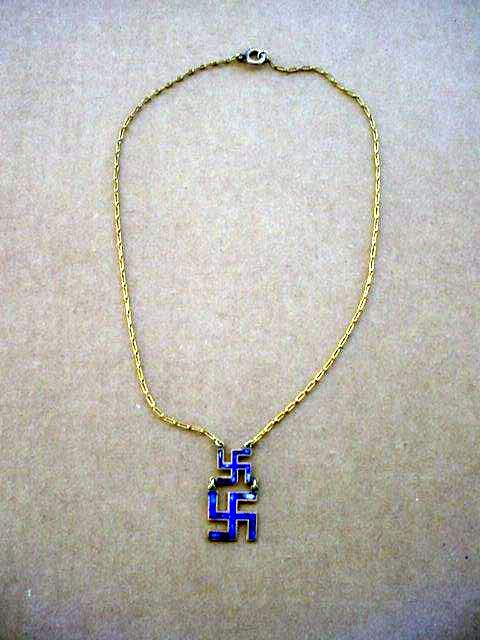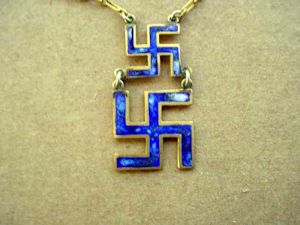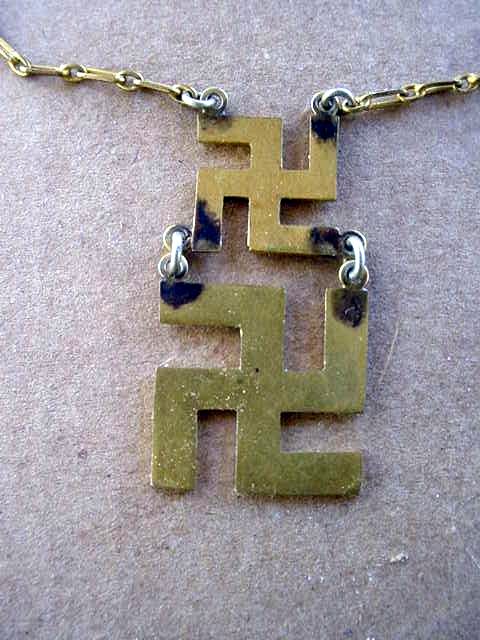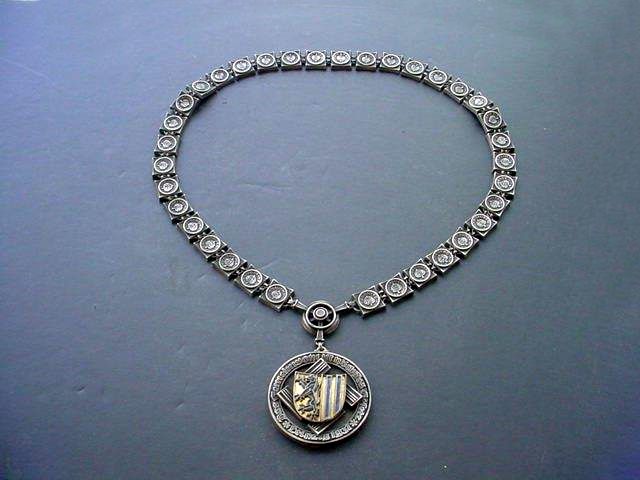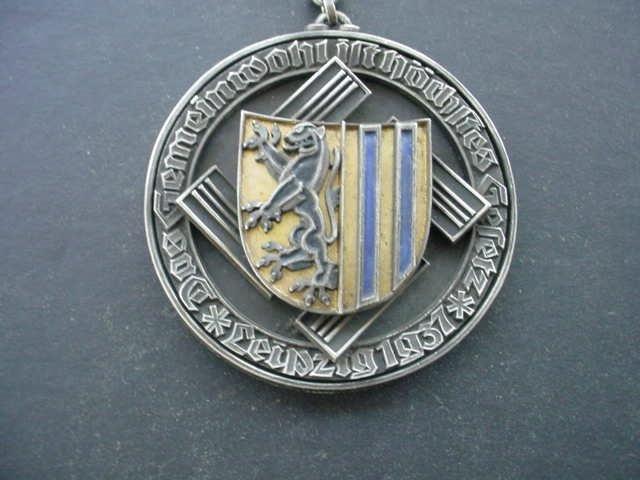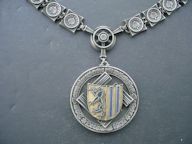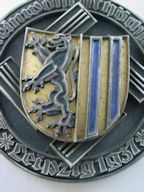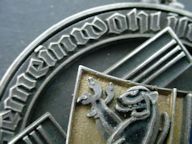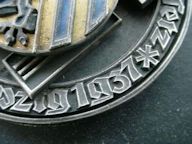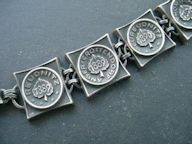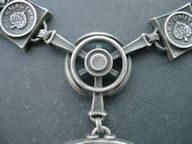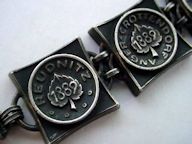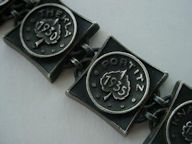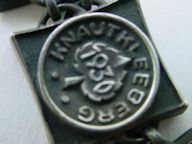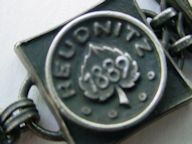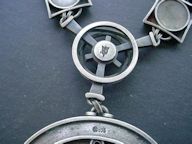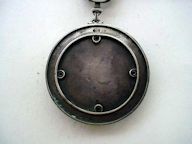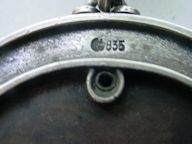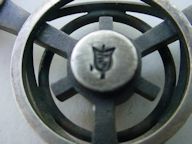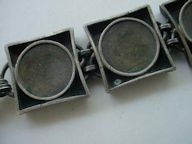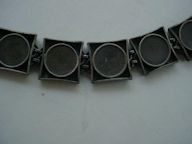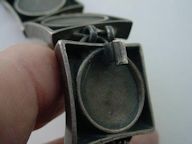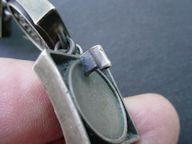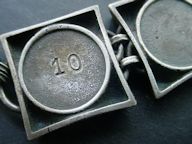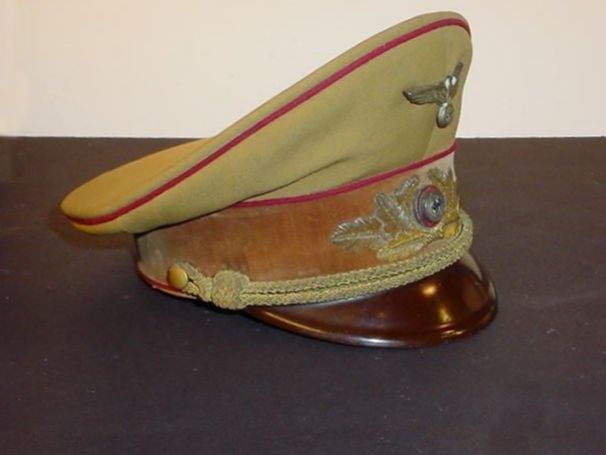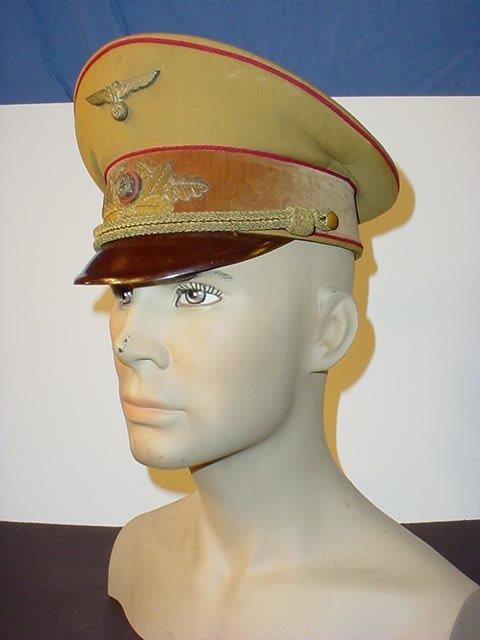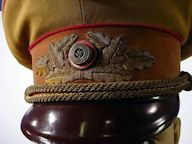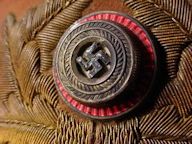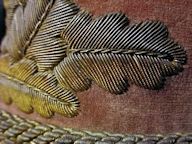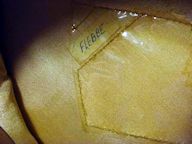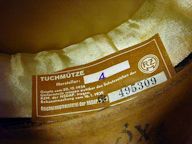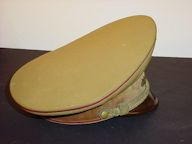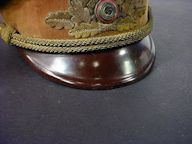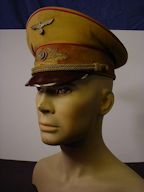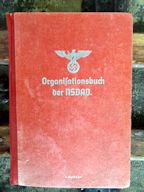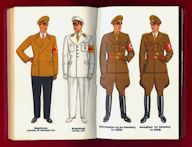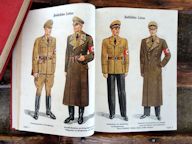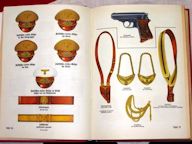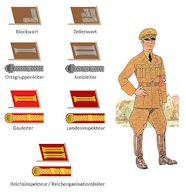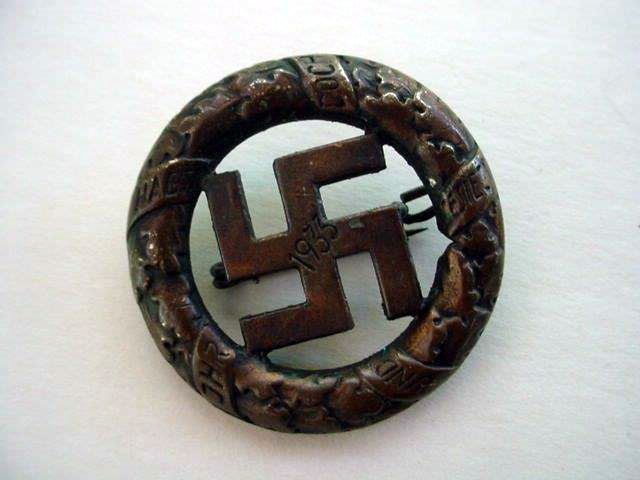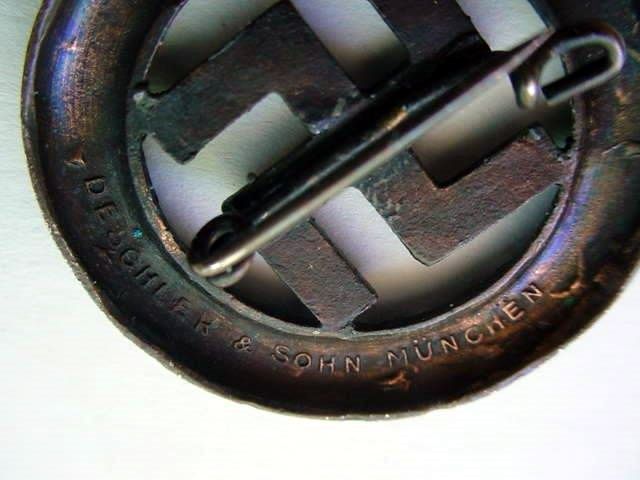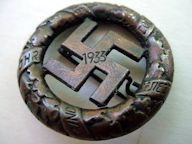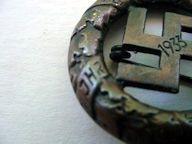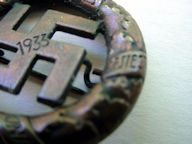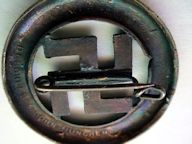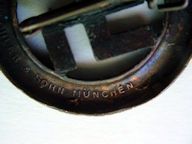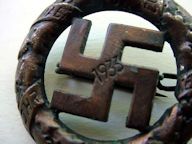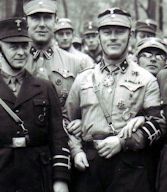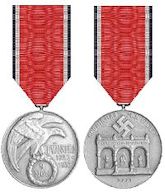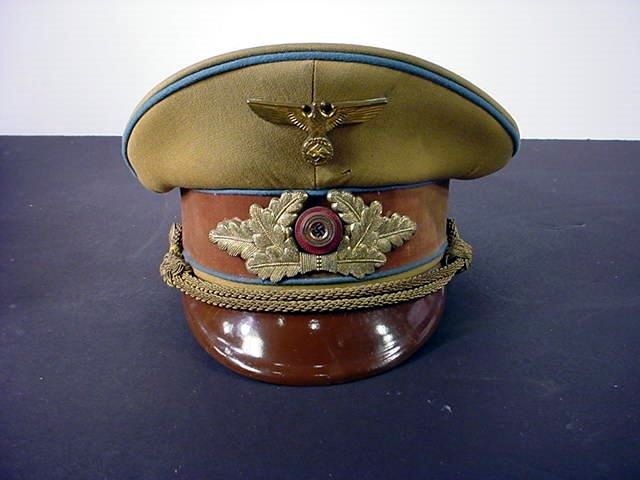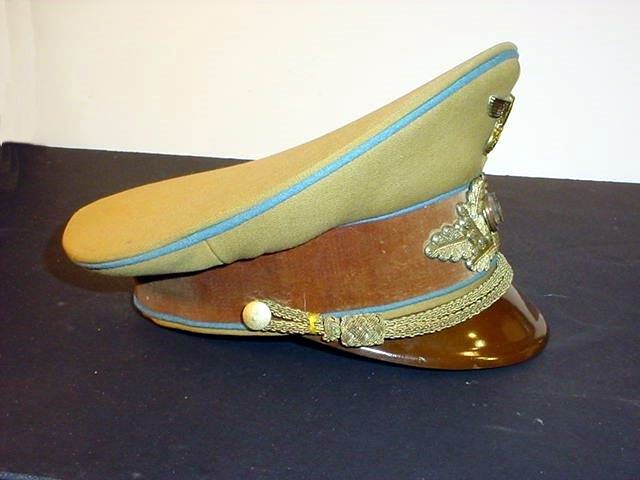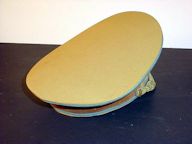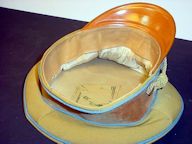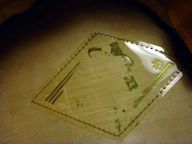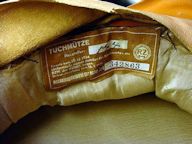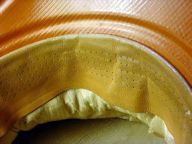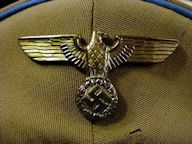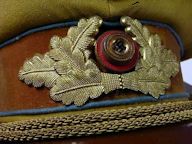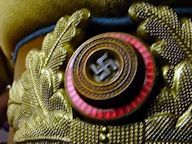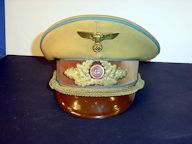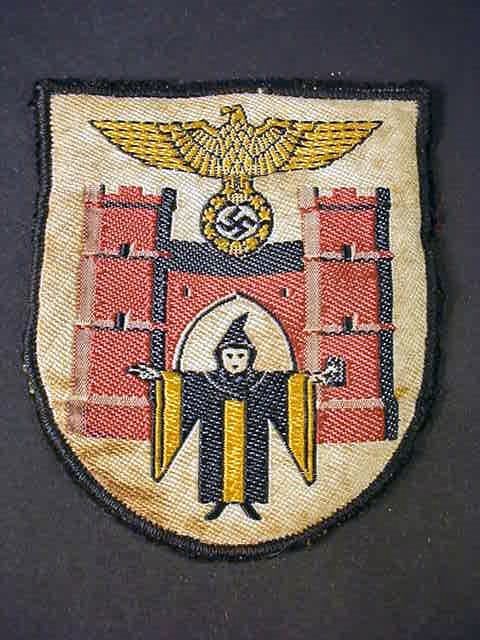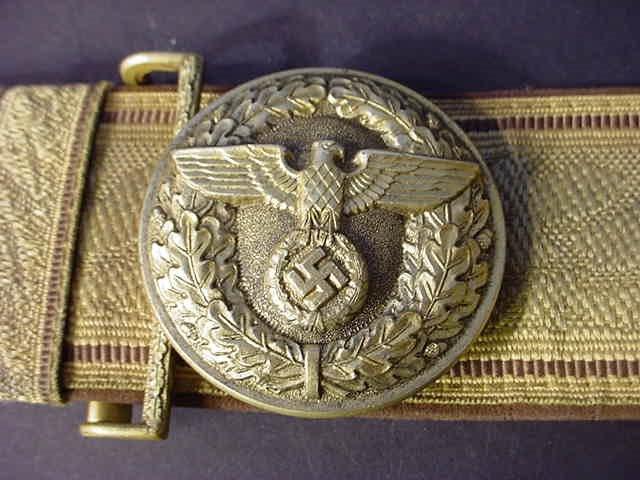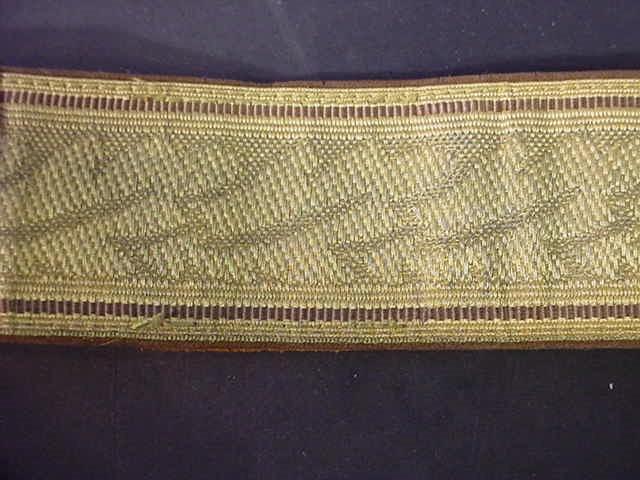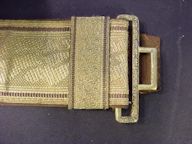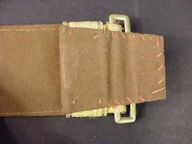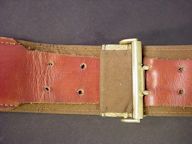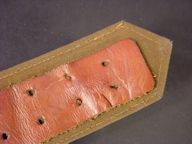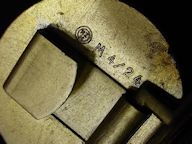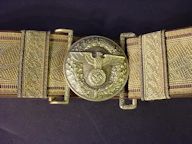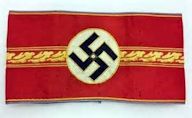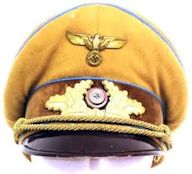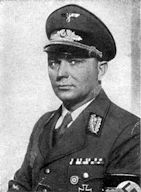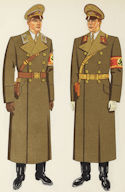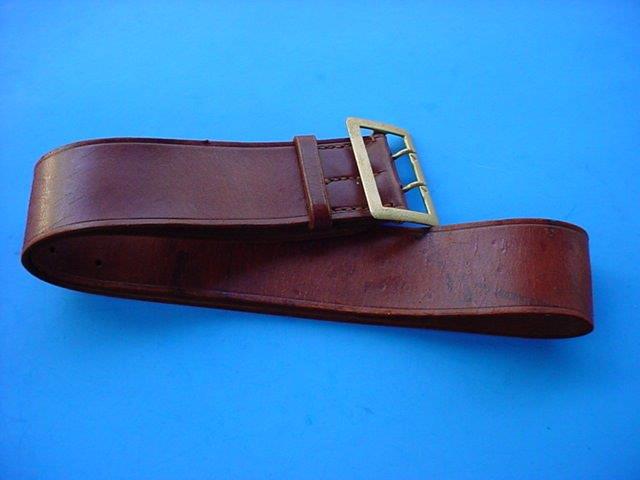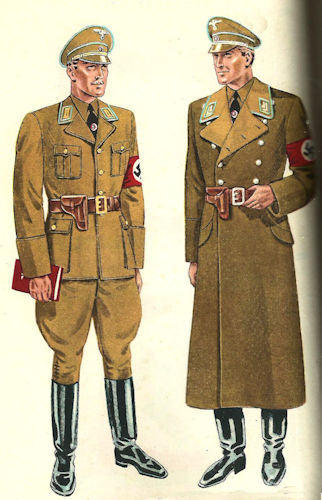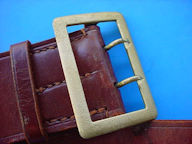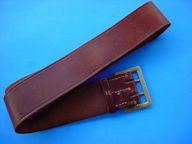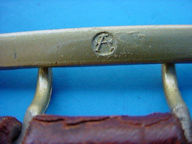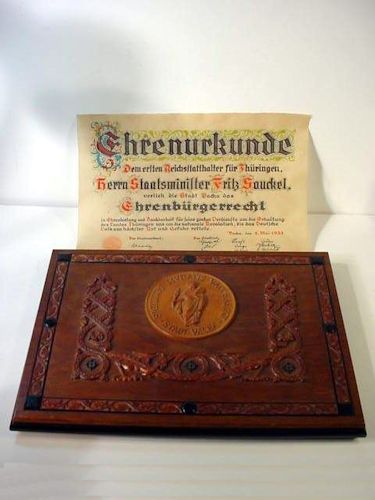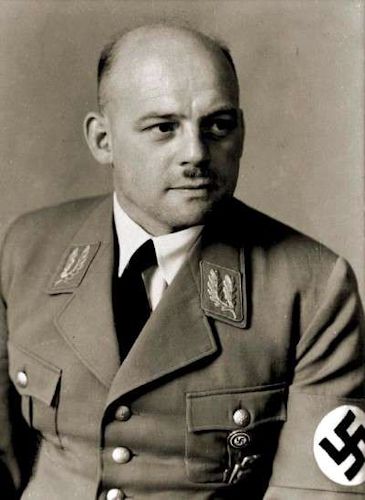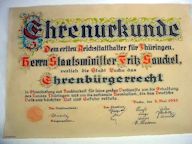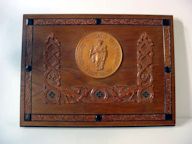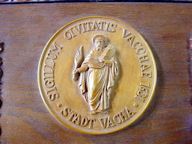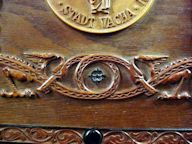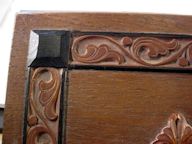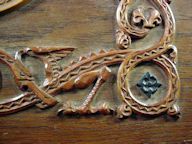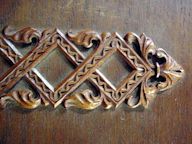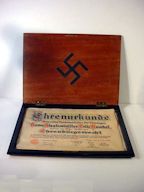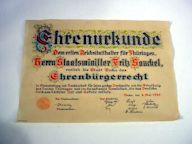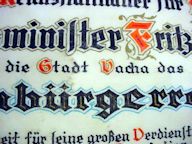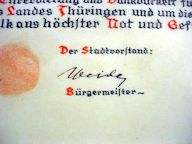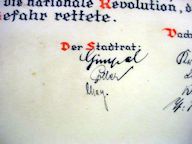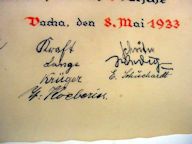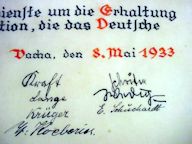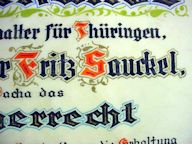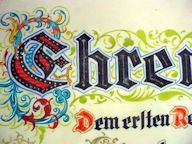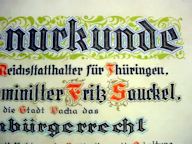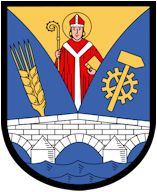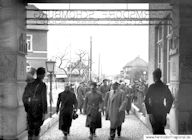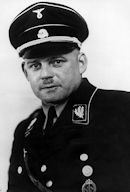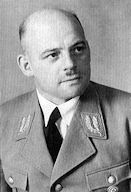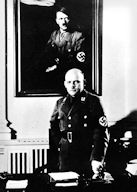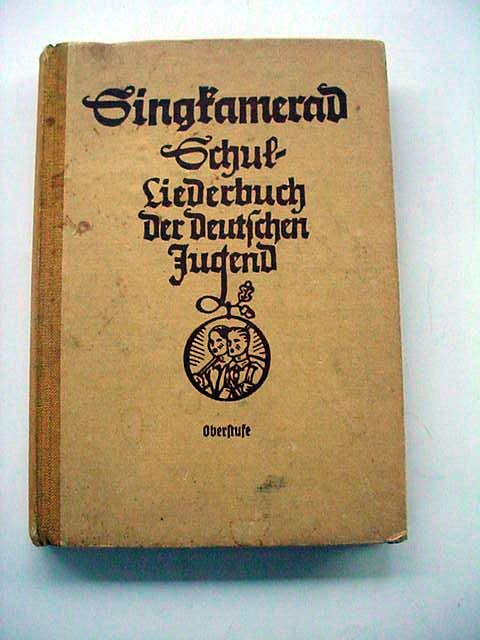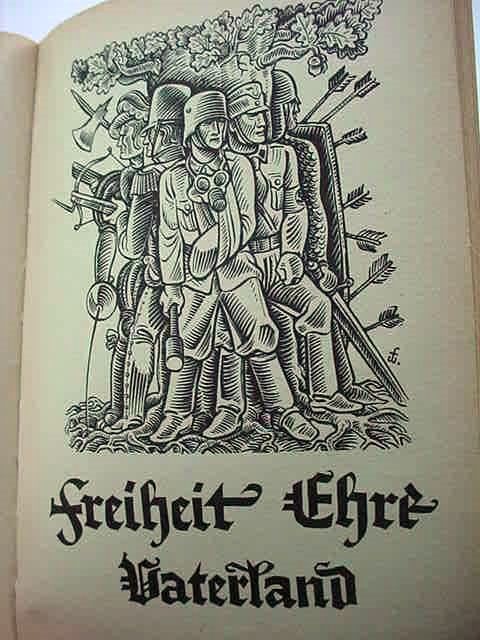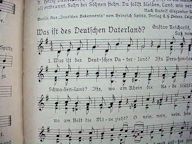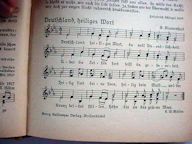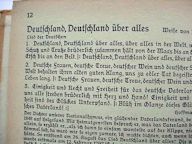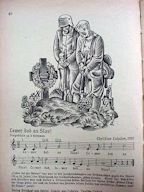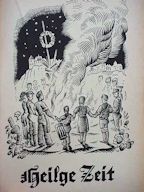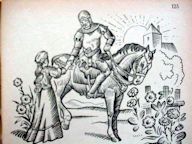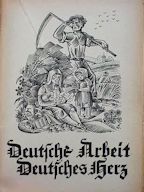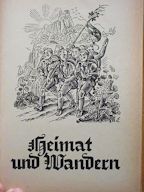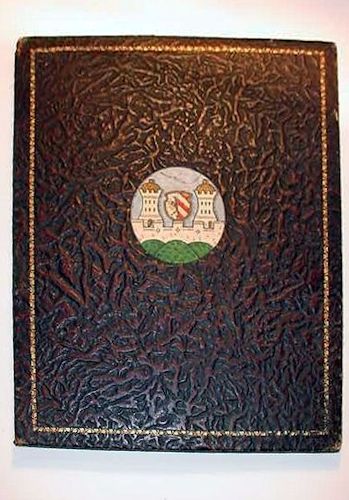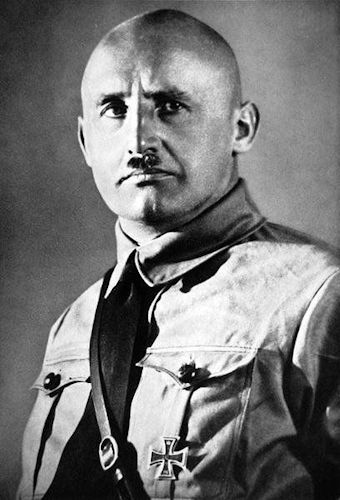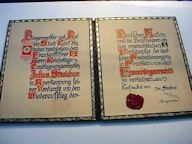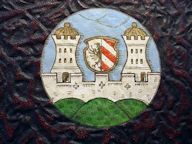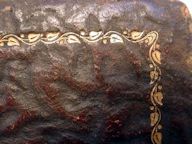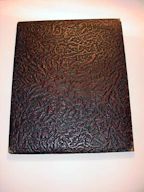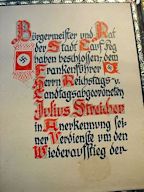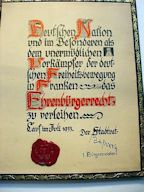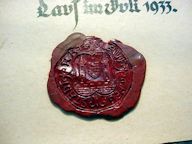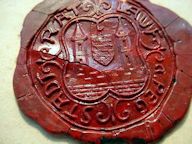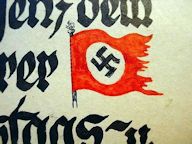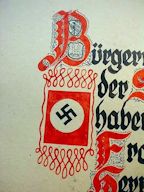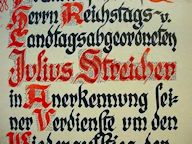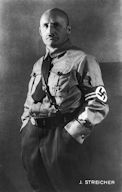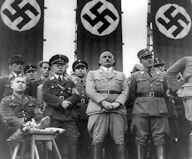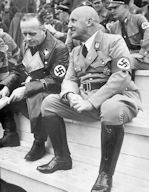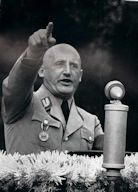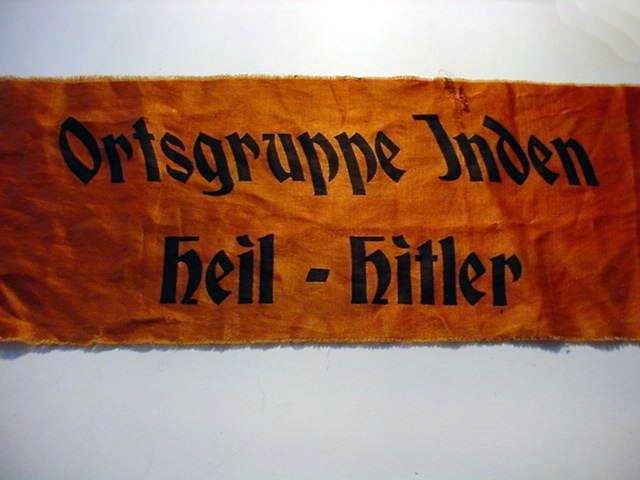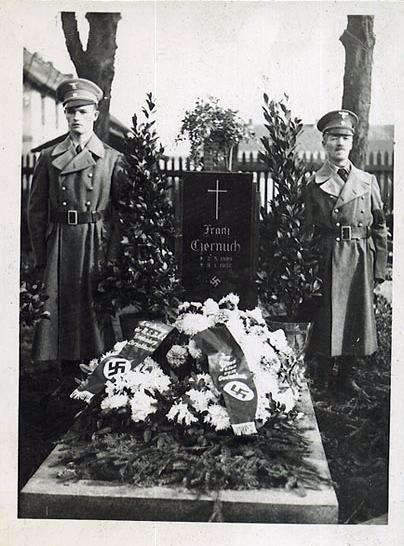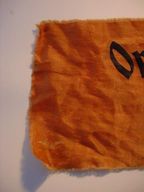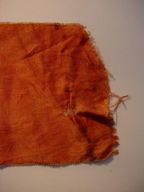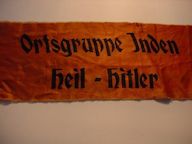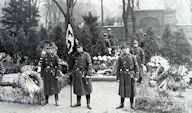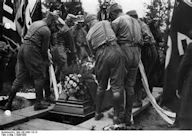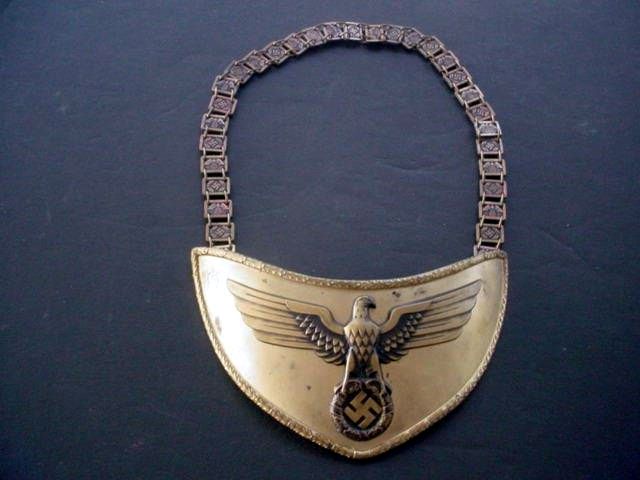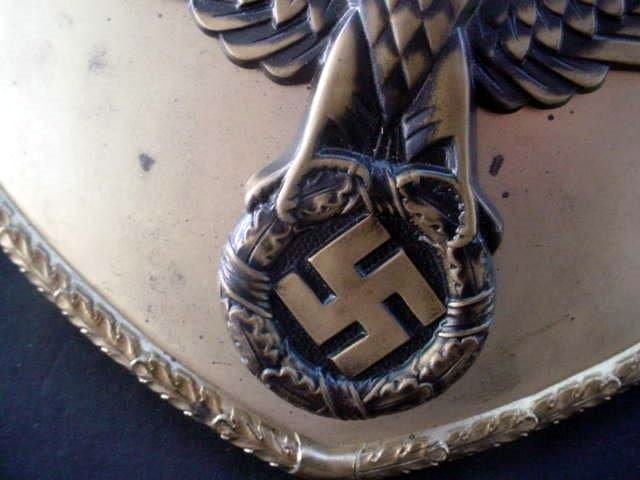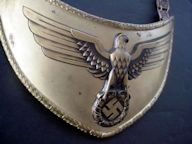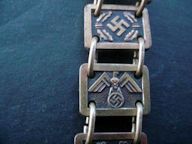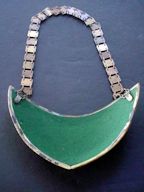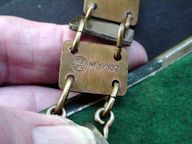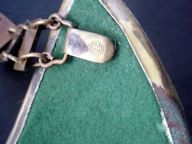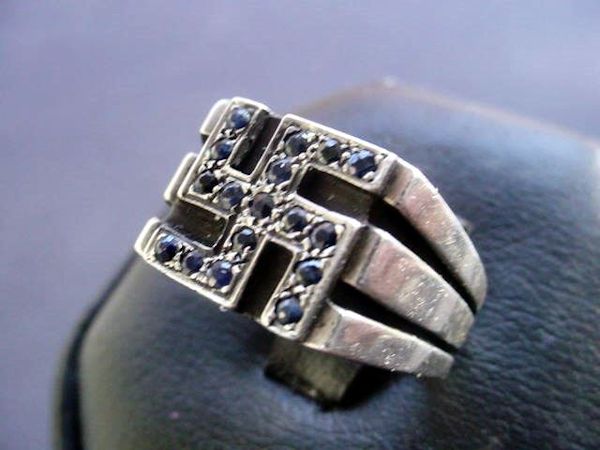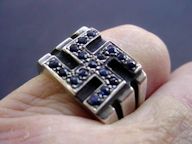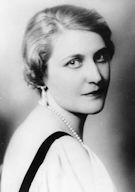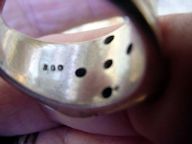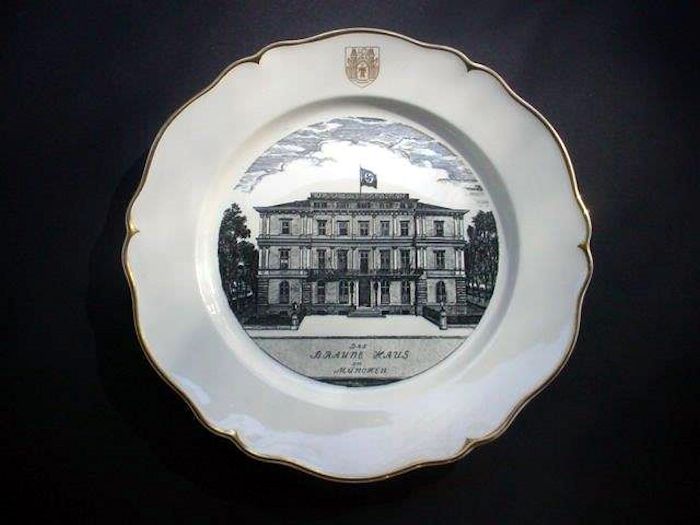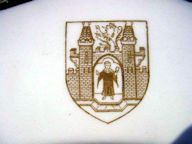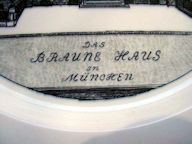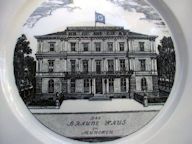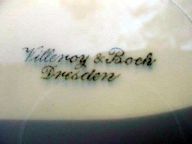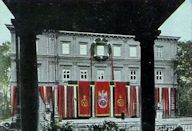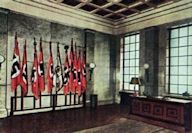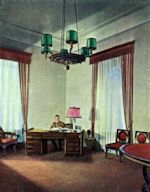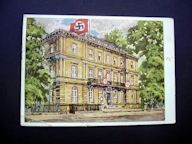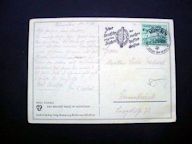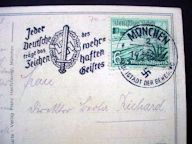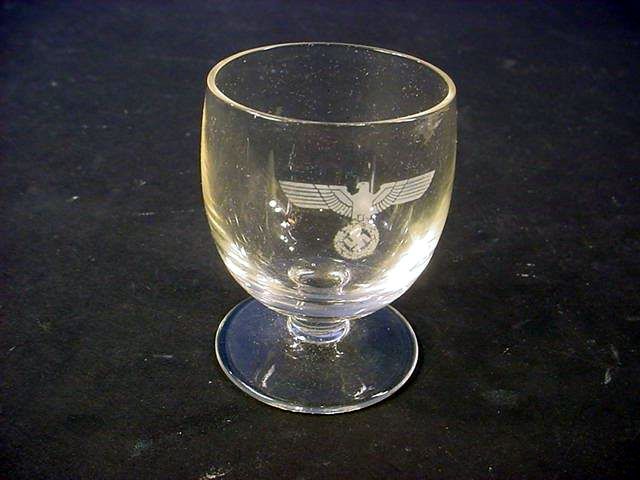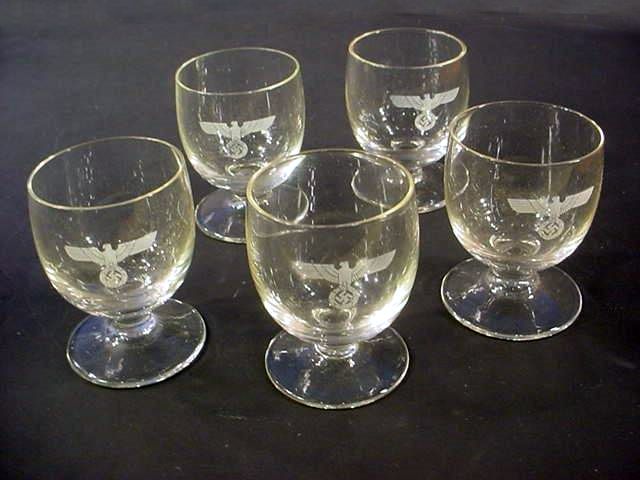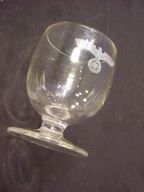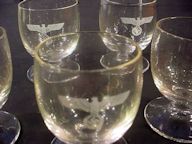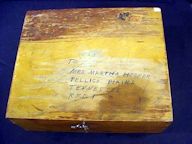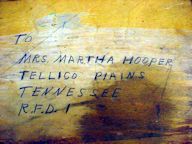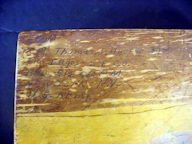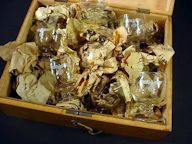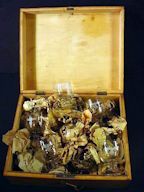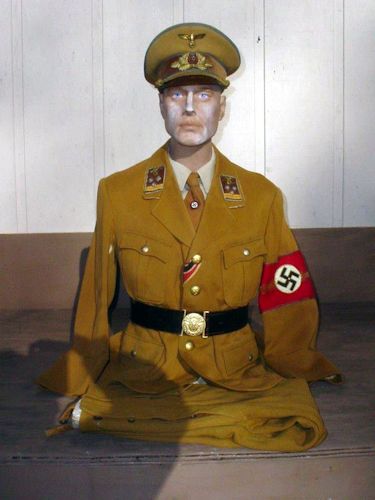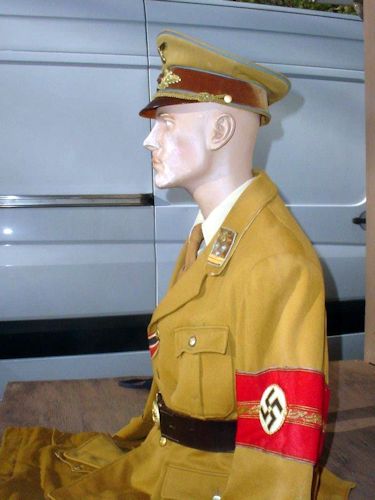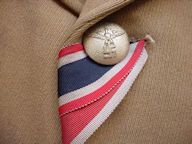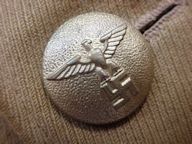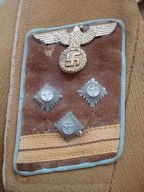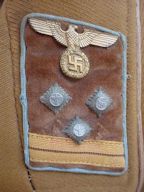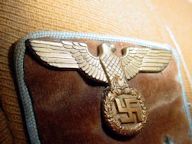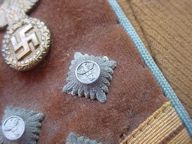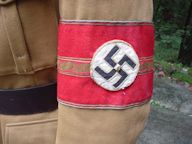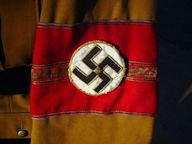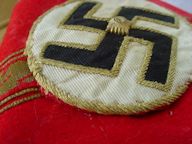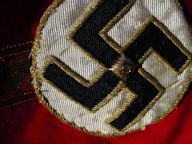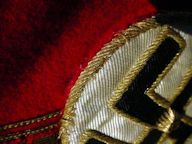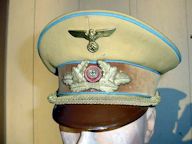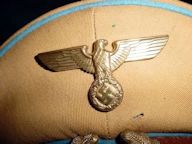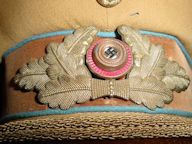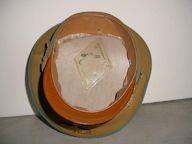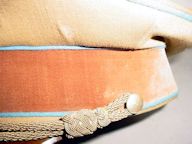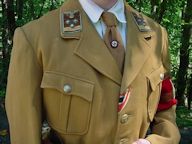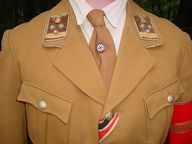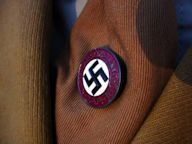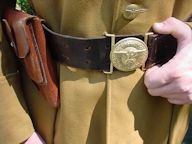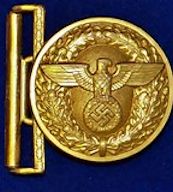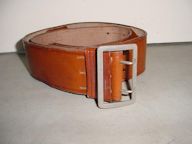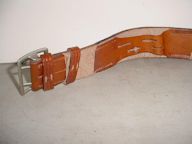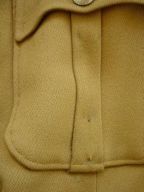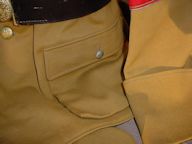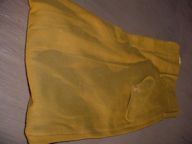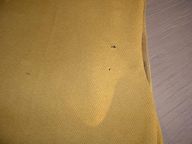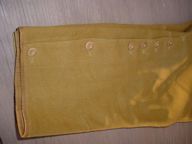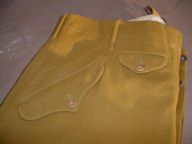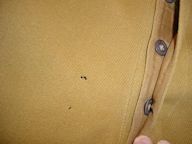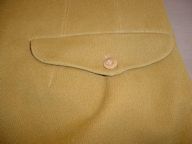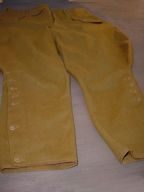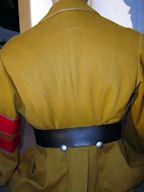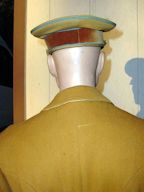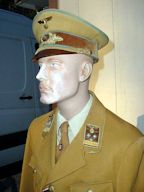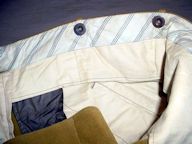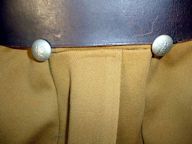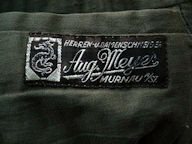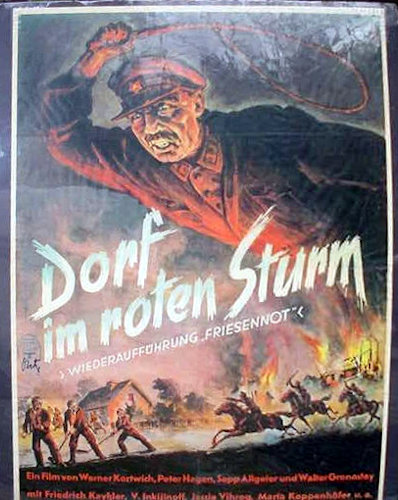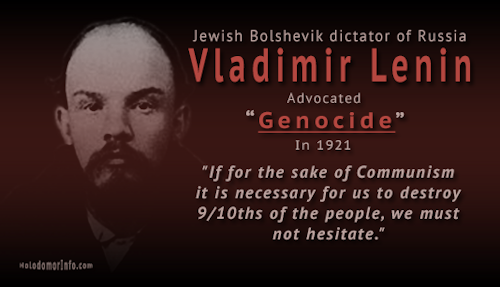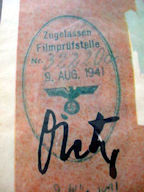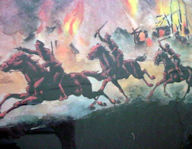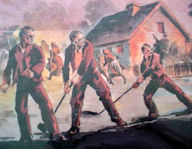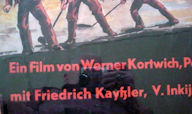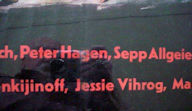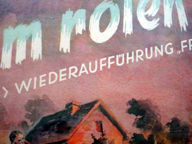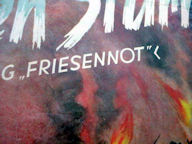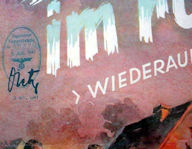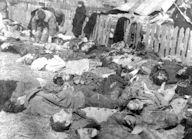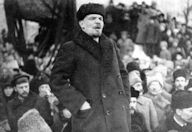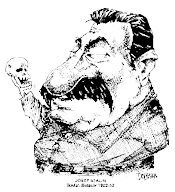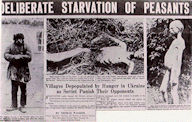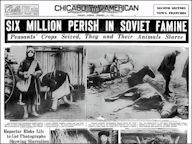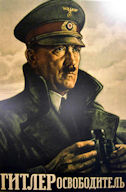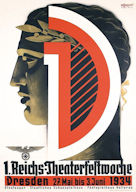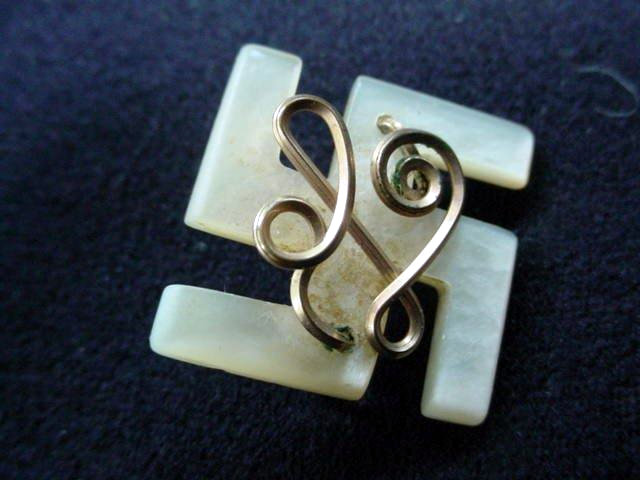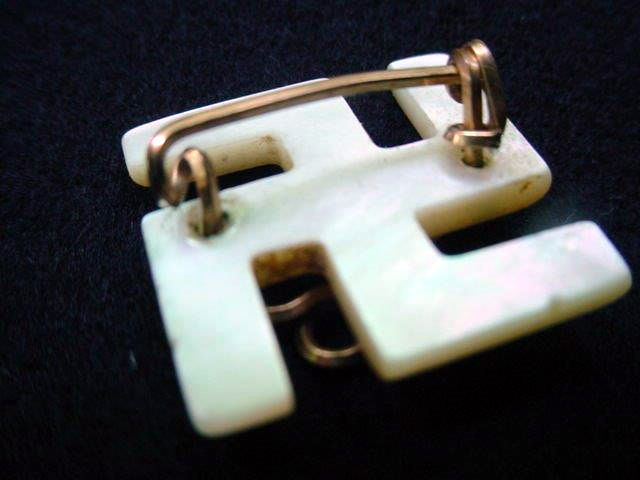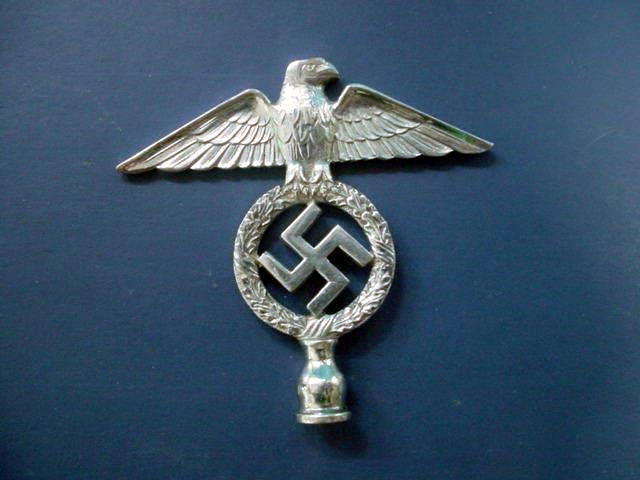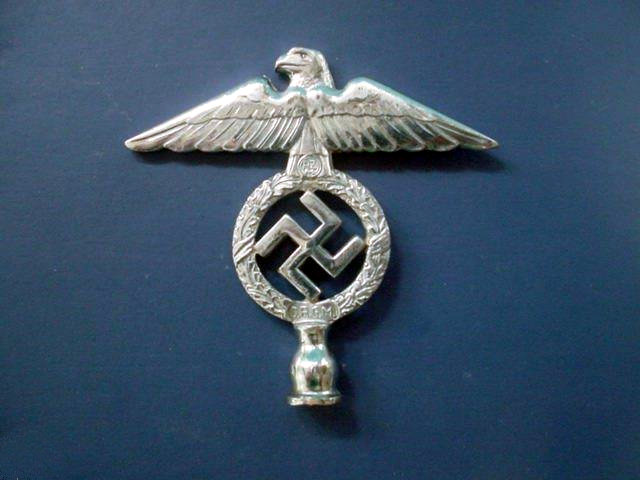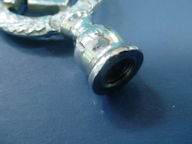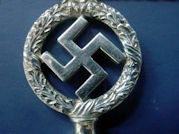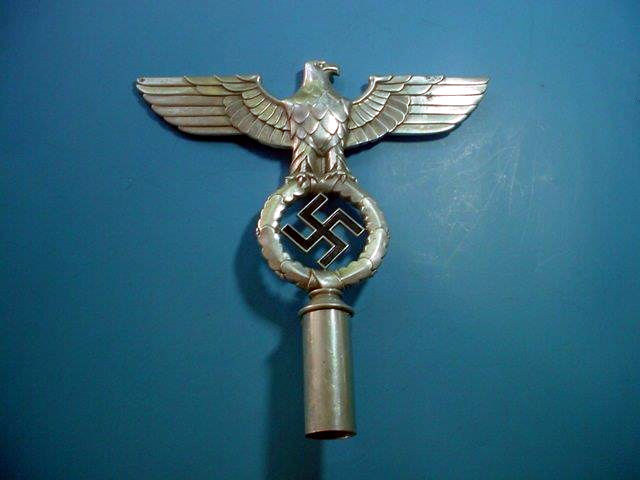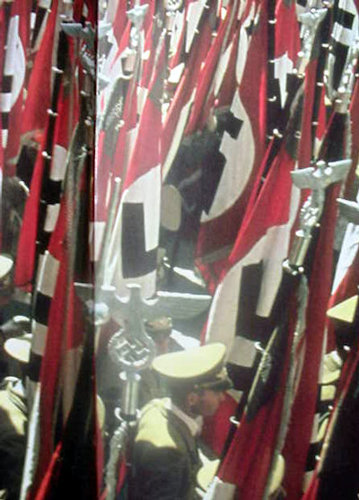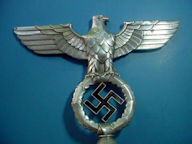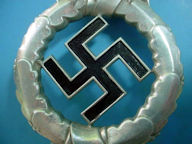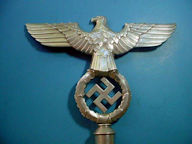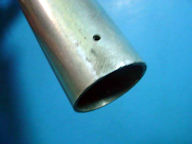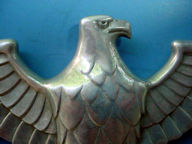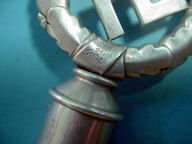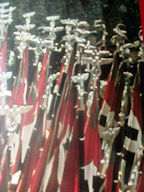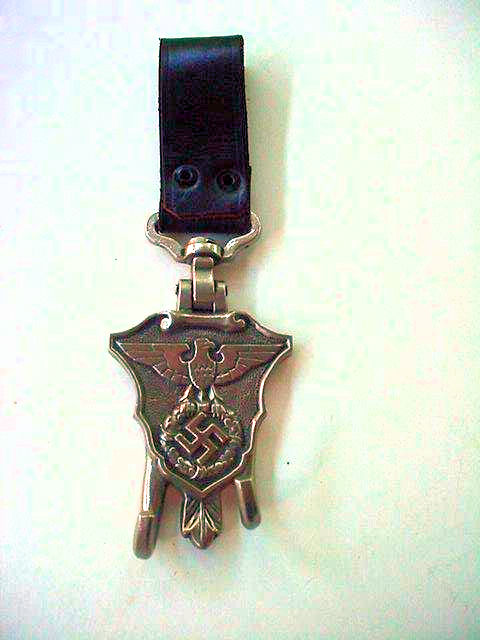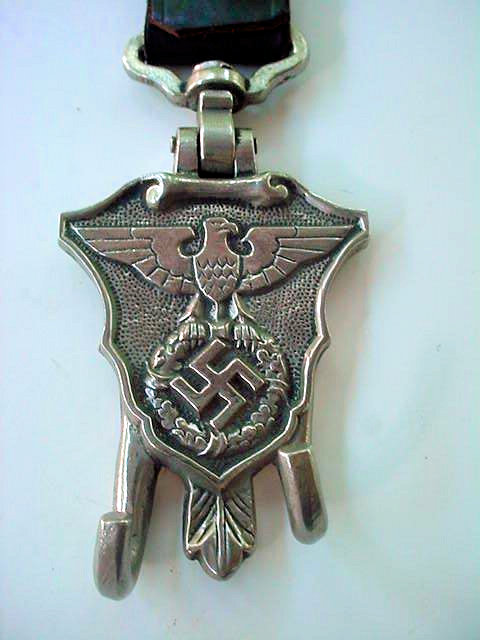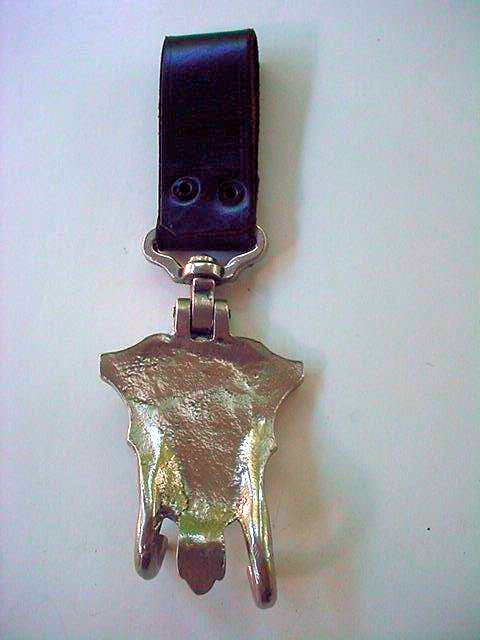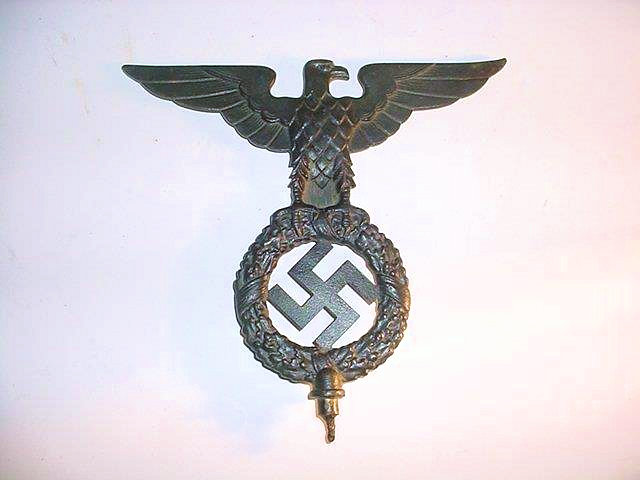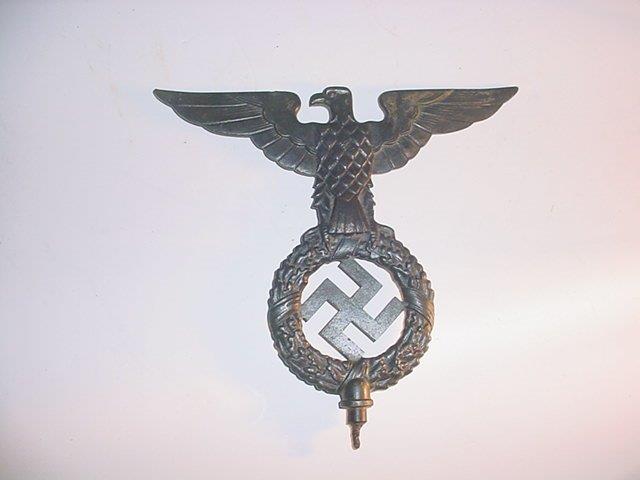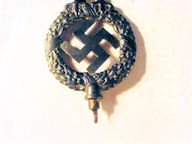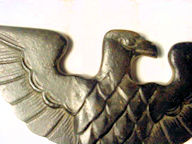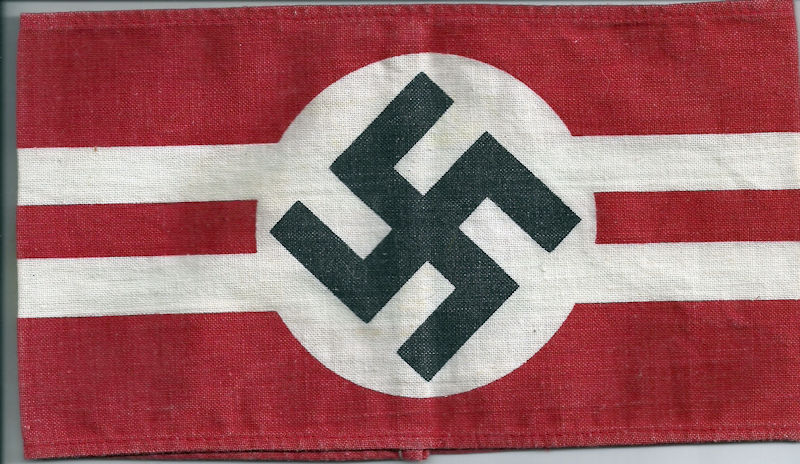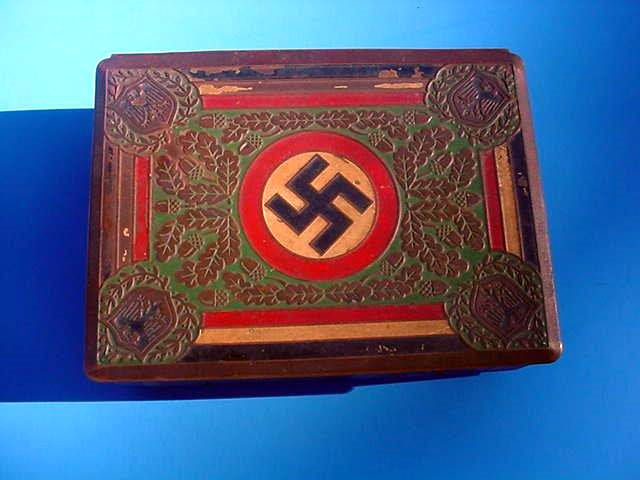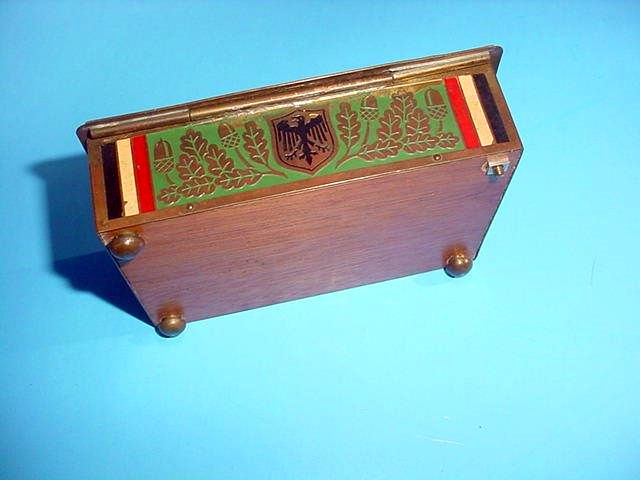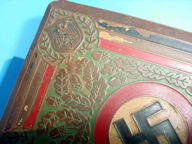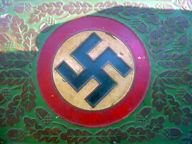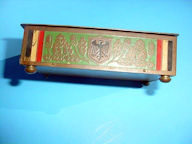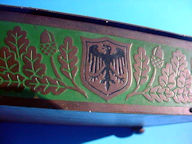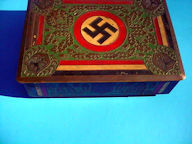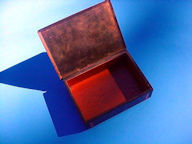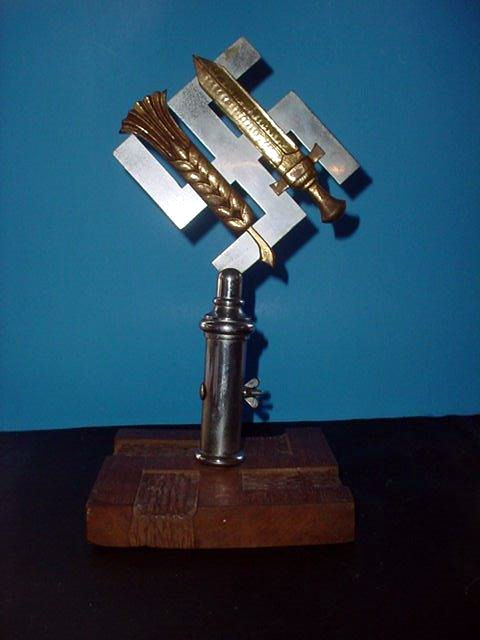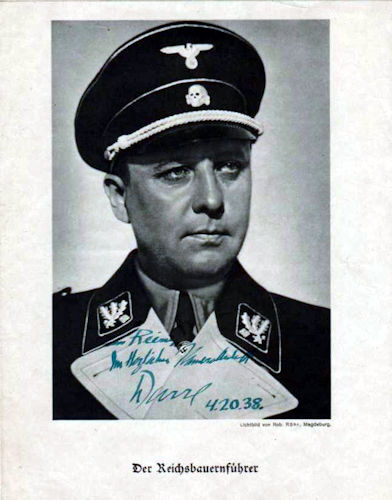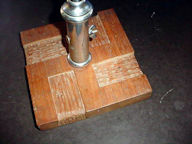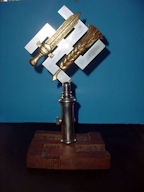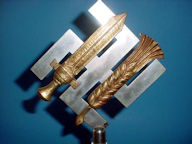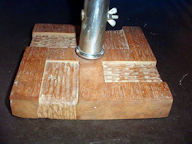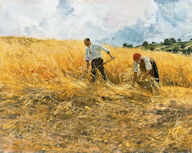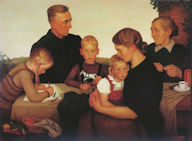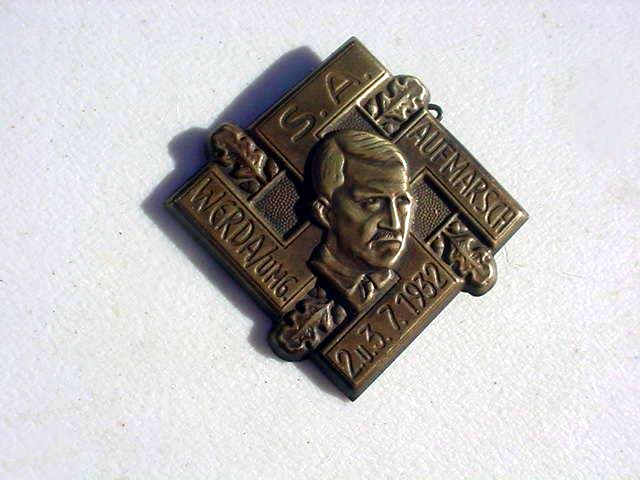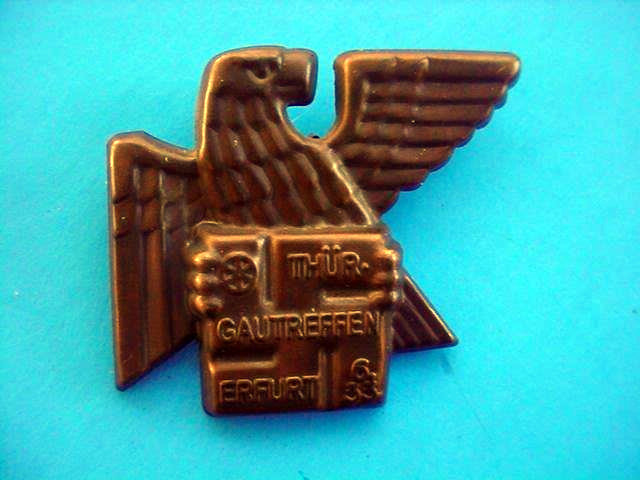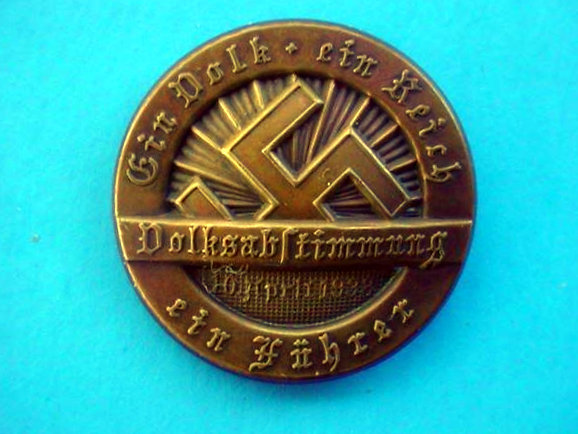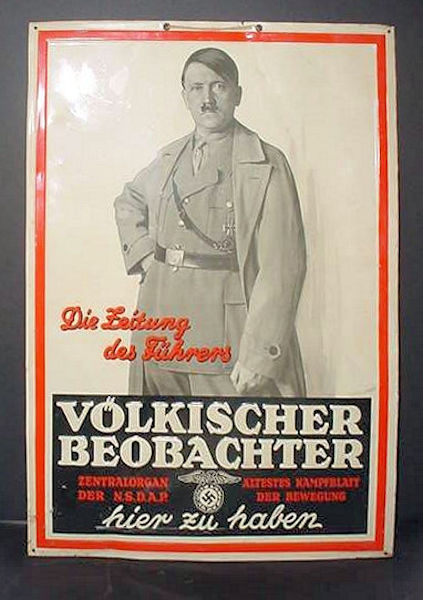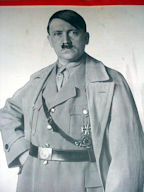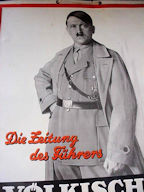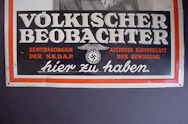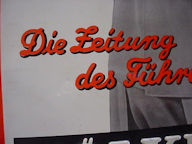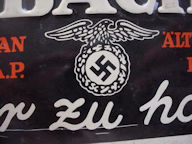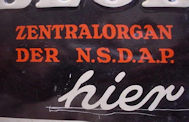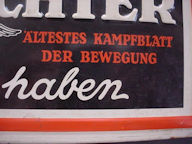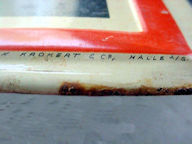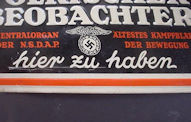|
|
|
|
N.S.D.A.P.
The Nazi Party
Page 21
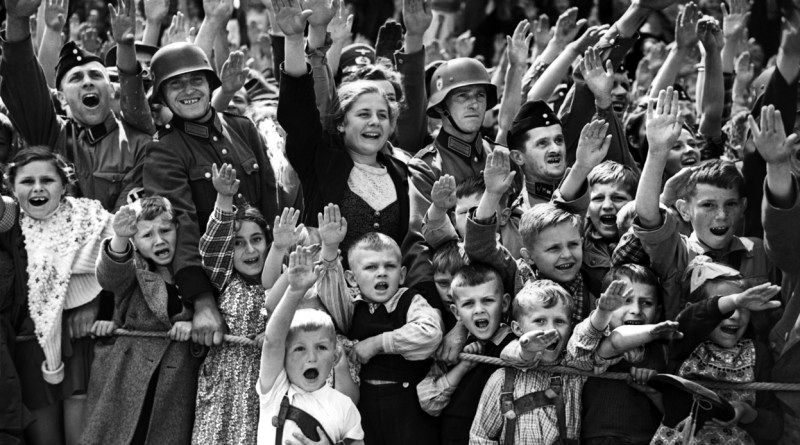
|
|||
|
National Socialist Swastika Necklace |
|||
| DESCRIPTION: Here is a very beautiful necklace comprised of two swastikas (one large, one small). One is suspended above the other and they are attached to a gold chain. I assume that the enameled swastikas are backed in gold; however, we sell them as rare N.S. jewelry, not for their metallic content. The piece was purchased in Munich from a lady who said her mother received it from the Lord Mayor of Munich in appreciation of her diligent service as his official secretary. The mayor’s name was Karl Fiehler and he was mayor from 1933 after the Machtergreifung (seizure of power) of the NSDAP until 1945. He was most loyal to the party and the people of this Hauptstadt der Bewegung (Head City of the Movement) and he was evidently very generous to his staff. The larger of the two enameled swastikas measures about ¾ inch on each side, and the smaller measures about ½ inch on each side. The chain is about 16 inches long. Condition is excellent with no apparent markings.
PRICE: $350.00 |
|
||||||||||||||||||||||
|
Wonderful Mayor’s Chain from the N.S. era in the City of Leipzig |
||||||||||||||||||||||
| DESCRIPTION: Here is one of the most important pieces of National Socialist paraphernalia that we have ever offered. It’s a Bürgermeister Kette or mayor’s symbol of office. It’s dated 1937, and in that particular year there were actually two mayors that held that post; one was Rudolf Haake who was the Hoch Bürgermeister, and a deputy mayor Kurt Walter Donicke,
who had all the mayoral authority of Haake. In fact they were both highly esteemed leaders and both would have worn a chain of office. One of these chains showed up years ago and was brought back by Mr. R.L. Lawrence of Arlington, Texas. The one we offer is of course one of the two; we don’t know the whereabouts of the present collection. This chain is exquisitely constructed of solid “835” silver and so marked. The links in the chain represent every district by name that came under the authority of the Leipzig Gau Saxon and the year they were incorporated. There are 35 of these links. The central medallion is well marked with the crown, moon, and silver designation of “835” and the three-spoked suspension device is marked with the logo of the silversmith who constructed the chain. The chain weighs an impressive one pound six ounces and is an outstanding subject for further research. The central design is comprised of three separate planchets superimposed over each other. The top one has the black rampant lion of Leipzig with two blue stripes lying upon a golden shield. Under this is the ribbed swastika that is resting upon the circular vortex that has an inscription in raised letters that comes out to read something about the laws and regulations concerning all the municipalities and public welfare. This is a very important piece of German WWII history and a particularly beautiful example of the mastery and superiority of German metallic jewelry artisans. This particular item was designed by famed silvermaster Alfred Schafter. A Bürgermeister was a very prestigious rank in the National Socialist sphere of lawgivers, especially if said mayor was installed in a large metropolitan city like Munich, Berlin, and especially Leipzig, which was a sacred city to the German people for it was here that Napoleon Bonaparte met his greatest defeat in October of 1813; this monumental struggle was called the Battle of Nations because a coalition of the armies of Russia, Prussia, Austria, and Sweden led by Tsar Alexander I of Russia decisively defeated the French Army. The battle was the culmination of the 1813 German campaign and involved over 600,000 soldiers, making it the largest battle in Europe prior to WWI. For the French emperor it was the beginning of the end and as we know, the great Prussian marshal Gebhard von Blücher of Leipzig battle fame along with his “children” (Prussian soldiers) went on to deliver the last knockout blow to Bonaparte at Waterloo June 18, 1815. Without the Marshal Vorwarts Blücher the English would have decidedly lost. So, the German people have long held a deep reverence for their marshal and Leipzig and the Battle of Nations that radically changed history for the better until the bitter end of WWII.
PRICE: $15,000.00 |
|
|
|
Gau Munich Commemorative Badge (Item NSD 21-4) |
|
DESCRIPTION: These were the words on the most sacred of all National Socialist medals. It means “And yet you conquered” and it was presented to the surviving members of the N.S. fighters who marched from Munich’s beer hall known as the Bürgerbräukeller to the Feldherrenhalle in the center of the city where they met a hail of bullets fired by the army and Munich police. This began on November 8, 1923, and the massacre occurred the following day. That event was commemorated every year thereafter up until 1934 when the march was cancelled by the Führer, but he decreed a national endowment for the martyrs of the movement. The badge is by the famed firm of Deschler & Sohn in Munich. It measures about 1 ½ inches in diameter. It is a bronze wreath of oak leaves with five interspersed words within that bear the message: “Und Ihr habt doch gesiegt.” We feel that it might have been the first type of a badge commemorating that event and is not to be confused with the medal, even though the medal bears the same words. When found, the medal sells for a very significant amount of money because of its heavy historical importance. This badge is also quite rare--maybe as rare as the medal--but the beauty of the silver medal and its romantic mythos make it highly desirable. Also, from the numbers stamped on its surface, it's possible to determine just whom it was issued to. With this badge there was no actual accounting as to whom received one! They were made by two Munich firms, but the “Deschler”-produced one as this one is has been the most highly sought-after example. The last time we offered one of these prestigious badges was at least 15 years ago. They are for sure quite rare. The medal of the Blood Order was instituted in March 1934. The Blood Order never was considered a replacement for the badge. If one qualified for both he could wear both, but when in civilian clothing the Gau badge when worn on a jacket or shirt indicated after March 34 that this NS member had received the Order of the Blood and deserved much honor and prestige.
PRICE: $398.00; "Very fair" for a Deschler-marked example |
|
|
|
Political Leaders Visor Cap (Ortsgruppe) (Item NSD 21-5; GEN 14-32) |
|
DESCRIPTION: This is a very-nice quality example of a WWII NSDAP political leaders visor cap in well-preserved condition. This visor cap has light-blue colored piping, chin cord, and button color (gold) and color signifies that this cap’s original wearer was an Ortsgruppenleiter (Local Group Leader). This was an NSDAP rank and title which existed between 1930 and 1945.
The term first came into being during the German elections of 1930 and was traditionally and officially held by the N.S. Führer or leader of a town or city for the purposes of election-district organization. After 1933, though, the process of “Gleichschaltung,” the position of Ortsgruppenführer, evolved into being the supreme N.S. Leader of only large towns or cities. The cap bears the N.S. Adler (eagle) and the gilded wreath in metal plus the cockade of red, black, and white (the national colors). Inside the caps lining can be seen the Reich’s RZM tag describing the cap as Tuchmütze (visor cap) and the series as #495309. The size is shown as 3-X (small). The inside crown’s celluloid sweat piece has a printed label identifying it as having belonged to a Parteigennosse (Party member Flebbe). This is a very choice N.S. uniform item; all original, rare, and in superb condition.
PRICE: $1,350.00 |
|
Extremely Rare Patch from Munich (Item NSD 21-6)
PRICE: SOLD
|
|
|
|
NSDAP Political Leader’s Brocade Belt and Buckle (Item NSD 21-7) |
|
DESCRIPTION: Here in beautiful shape is one of the rarest belt assemblages used among the uniformed personnel of the Third Reich. The political leaders were the group who were the most ornately festooned among the German officialdom. They were most appreciated because of their dedication to various social services and representing the common Volk, but the rank-and-file folks often referred to them as “golden pheasants” (privately, of course). On strictly special occasions, these officials wore this elaborate brocade belt as part of the high-dress uniform and this one we offer is practically a mint-condition example of this rare accouterment. Some of these were backed with a rich brown velvet material while some were encountered with a more simple velveteen backing. The fine brocade has a beautifully presented woven oak-leaf pattern. This is very much like the political leaders armband. The buckle is a fine, detailed example and it is also in great condition and retains its entire luster. It’s slightly smaller than the one used in the political leader leather belt. The buckle has all the RZM designation—“M 4/24.” This set very seldom comes up and would absolutely upgrade the appearance of a political leader’s uniform or would make a great display on its own. This is extremely rare, and is highly sought after by the advanced collector.
PRICE: SOLD |
|
|
|
|
Political Leader or Wehrmacht Early Dress Belt by Assmann (Item NSD 21-7a; WEHR 35-15) |
|
DESCRIPTION: This is a prime example of an NSDAP high political leader's belt worn with the everyday uniform. It is also of the exact type worn by the higher ranks of the WW II German Army such as majors and generals. This is a textbook instance of a style of belt seldom found with the pebbled, open-claw buckle and showing highly gilded brass. The stylized Assmann "A" is clearly seen on the back of the buckle. The fine, supple leather belt is in almost mint condition and is about 45 inches long.
PRICE: $650.00; Seldom ever found! |
|
|
|
Honorary Citizenship Bestowed Upon the Minister of State Fritz Sauckel (Ehrenurkunde) (Item NSD 21-8; PERS 5-22) |
DESCRIPTION: Also referred to as Ehrenburgerrecht--that entitles honorary citizenship. In 1933, Adolf Hitler received literally hundreds of these items making him an honorary citizen of almost every large city and right down to the smallest dorf or burg. As you know, Hitler was born in Austria, but he longed from youth to be a German. Make no mistake the “Ostmark” (Austria) is essentially German, but geographical borders set it apart until the Austrian Anschluss that transpired after Hitler announced it on March 12, 1938. Austria was then officially part of the entity known as (Gross Deutschland) Greater Germany. When Hitler was appointed by Marshal Hindenburg as Reich’s Chancellor in 1933, most of the leftist journalists and numerous reactionary parties issued forth attacks against him and continually uttered the ad nauseam verbiage that accused him of not even being German. They continually rendered the statement that Hitler was not even a German he was an Austrian! It was then that one German city awarded him their honorary citizenship and after this, more than 4,000 towns did the same. They are very rare today and it is a fact that Hitler stored most of the actual certificates at the Berghof and because of an order issued to the  by the Führer, himself, most of them were destroyed along with all his personal possessions left at his Obersalzberg mountain retreat in 1945. The only ones to survive were those that were never sent, but archived in the town halls on display in showcases in the Ehrenzimmers of such buildings. A letter was sent from the high mayor of the town with a picture of the document on display to the offices of the Führer asking if this was acceptable and usually it was. We show one of these that you can see at AH 20-12 and another at AH 21-4. So, it was an established tradition that these grateful municipalities would honor their great leader, thusly. Now! There were also some more of these honorary citizenships that were sometimes bestowed on other National Socialist leaders, but very few have been found, and if ever located they usually are associated with the towns in the districts that the N.S. recipient would be most connected to. We once had one to Herman Göring and it was from the town of Veldenstein, the village that his castle was situated in, and one from Rheydt in the Rhineland to Dr. Joseph Goebbels. This was the town he was born in. Ehrenburgers to N.S. leaders other than Hitler are much more rare, but don’t usually command the prices brought by ones to the Führer. However, another factor in the collector’s value of any of these documents is the amount of fine artwork presented in some of them are extremely elaborate and generally include fantastic calligraphy extraordinaire! No two are ever alike of course but some are artistic masterworks without a doubt! Now, we have fortunately procured a really rare and beautiful one that was dedicated and presented to then minister of the state of Thuringia, Fritz Sauckel. Later, he became the Gauleiter of Thuringia. Ernst Friedrich Christoph “Fritz” Sauckel (27 October 1894-16 October 1946) was a German Nazi politician, Gauleiter and the General Plenipotentiary for Labor Deployment from 1942 until the end of the Second World War. During WW II, he was Reich’s defense commissioner for the Kassel district (Reichsverteidigungskommissar). He was born in Hassfurt (Kingdom of Bavaria), the only child of a postman and a seamstress. Sauckel was educated at local schools and left early when his mother fell ill. He joined the merchant marine of Norway and Sweden when he was 15, first on a Norwegian three-masted schooner, and later on Swedish and German vessels. He went on to sail throughout the world, rising to the rank of Vollmatrose.(master seaman ). At the outbreak of WWI, he was on a German vessel en route Australia when the vessel was captured. He was subsequently interred in France from August 1914 until November 1919. He returned to Germany, found factory work in Schweinfurt, and studied engineering in Ilmenau from 1922 to 1923. He joined the National Socialist German Worker’s party (NSDAP) in 1923 (member number 1395). In 1924 he married Elisabeth Wetzel, with whom he had ten children. He remained a party member over its dissolution and publicly rejoined in 1925. Sauckel was appointed party Gauleiter of Thuringia in in 1927 and became a member of the regional government in 1929. Following Hitler’s appointment as chancellor in 1933, he was promoted to Reich Regent of Thuringia and Reichstag member. He was also given an honorary rank of Obergruppenführer in the SA and the by the Führer, himself, most of them were destroyed along with all his personal possessions left at his Obersalzberg mountain retreat in 1945. The only ones to survive were those that were never sent, but archived in the town halls on display in showcases in the Ehrenzimmers of such buildings. A letter was sent from the high mayor of the town with a picture of the document on display to the offices of the Führer asking if this was acceptable and usually it was. We show one of these that you can see at AH 20-12 and another at AH 21-4. So, it was an established tradition that these grateful municipalities would honor their great leader, thusly. Now! There were also some more of these honorary citizenships that were sometimes bestowed on other National Socialist leaders, but very few have been found, and if ever located they usually are associated with the towns in the districts that the N.S. recipient would be most connected to. We once had one to Herman Göring and it was from the town of Veldenstein, the village that his castle was situated in, and one from Rheydt in the Rhineland to Dr. Joseph Goebbels. This was the town he was born in. Ehrenburgers to N.S. leaders other than Hitler are much more rare, but don’t usually command the prices brought by ones to the Führer. However, another factor in the collector’s value of any of these documents is the amount of fine artwork presented in some of them are extremely elaborate and generally include fantastic calligraphy extraordinaire! No two are ever alike of course but some are artistic masterworks without a doubt! Now, we have fortunately procured a really rare and beautiful one that was dedicated and presented to then minister of the state of Thuringia, Fritz Sauckel. Later, he became the Gauleiter of Thuringia. Ernst Friedrich Christoph “Fritz” Sauckel (27 October 1894-16 October 1946) was a German Nazi politician, Gauleiter and the General Plenipotentiary for Labor Deployment from 1942 until the end of the Second World War. During WW II, he was Reich’s defense commissioner for the Kassel district (Reichsverteidigungskommissar). He was born in Hassfurt (Kingdom of Bavaria), the only child of a postman and a seamstress. Sauckel was educated at local schools and left early when his mother fell ill. He joined the merchant marine of Norway and Sweden when he was 15, first on a Norwegian three-masted schooner, and later on Swedish and German vessels. He went on to sail throughout the world, rising to the rank of Vollmatrose.(master seaman ). At the outbreak of WWI, he was on a German vessel en route Australia when the vessel was captured. He was subsequently interred in France from August 1914 until November 1919. He returned to Germany, found factory work in Schweinfurt, and studied engineering in Ilmenau from 1922 to 1923. He joined the National Socialist German Worker’s party (NSDAP) in 1923 (member number 1395). In 1924 he married Elisabeth Wetzel, with whom he had ten children. He remained a party member over its dissolution and publicly rejoined in 1925. Sauckel was appointed party Gauleiter of Thuringia in in 1927 and became a member of the regional government in 1929. Following Hitler’s appointment as chancellor in 1933, he was promoted to Reich Regent of Thuringia and Reichstag member. He was also given an honorary rank of Obergruppenführer in the SA and the  in 1934. Saukel was arrested after the war and attempted to defend his actions. At the Nuremberg Trials he did not refer to any of the victims as slave laborers. Sauckel argued that the whole process of using laborers was simple economics and he denied that there was any systematic mistreatment of them. “If mistreatment did occur,” he said, “it was the result of rogue guards and local commands.” Writing the sheer scale of what he was trying to achieve this had to be expected and could not be countered. His defense team pointed out that Sauckel had sent out instructions to regional commanders of slave laborers that they should be treated with “adequate care.” Investigation in later years proved this to be for the most part true, but it must be noted that the Nuremberg Trials were nothing but a Star Chamber sham hearing calling itself a war-crimes tribunal. They were so fraudulent that they could not possibly have been held in America since the U.S. (so far) prohibits kangaroo-court tactics with such ex post facto charges and hearsay testimony. Dwight Eisenhower’s brother Edgar, a lawyer, called these Nuremberg “trials” a sham, saying that the trials cannot be justified by any line of reasoning. Supreme Court Chief Justice Harland Fisk Stone stated (while the trials were underway mind you) that the proceedings were a high-grade lynching party and a fraud. When we acknowledge this statement wouldn’t we come to the expectation that something was amiss? The fact is the Nuremberg process in itself was not a judicial process at all! Rather, it was a staged act of vengeance against the defeated, and it was particularly profaned by the fact the Russians with the blood of innocents still dripping from their hands were among the judges and were themselves of course guilty of multitudes of murderous scenarios far beyond the measure of crimes and atrocities that were now leveled at the Germans. Irish author Michel Walsh has written a brilliant synopsis of the trials. So was the indictment by this phony ‘court’ to be considered within law with fairness, and judicial decency? I’ll leave this to you to decide. Fritz Sauckel was probably innocent of all the ex post facto crimes dreamed up by the so-called Tribunal. I think he was a man who came to the fore when his country truly needed him. Enough said? I think so. in 1934. Saukel was arrested after the war and attempted to defend his actions. At the Nuremberg Trials he did not refer to any of the victims as slave laborers. Sauckel argued that the whole process of using laborers was simple economics and he denied that there was any systematic mistreatment of them. “If mistreatment did occur,” he said, “it was the result of rogue guards and local commands.” Writing the sheer scale of what he was trying to achieve this had to be expected and could not be countered. His defense team pointed out that Sauckel had sent out instructions to regional commanders of slave laborers that they should be treated with “adequate care.” Investigation in later years proved this to be for the most part true, but it must be noted that the Nuremberg Trials were nothing but a Star Chamber sham hearing calling itself a war-crimes tribunal. They were so fraudulent that they could not possibly have been held in America since the U.S. (so far) prohibits kangaroo-court tactics with such ex post facto charges and hearsay testimony. Dwight Eisenhower’s brother Edgar, a lawyer, called these Nuremberg “trials” a sham, saying that the trials cannot be justified by any line of reasoning. Supreme Court Chief Justice Harland Fisk Stone stated (while the trials were underway mind you) that the proceedings were a high-grade lynching party and a fraud. When we acknowledge this statement wouldn’t we come to the expectation that something was amiss? The fact is the Nuremberg process in itself was not a judicial process at all! Rather, it was a staged act of vengeance against the defeated, and it was particularly profaned by the fact the Russians with the blood of innocents still dripping from their hands were among the judges and were themselves of course guilty of multitudes of murderous scenarios far beyond the measure of crimes and atrocities that were now leveled at the Germans. Irish author Michel Walsh has written a brilliant synopsis of the trials. So was the indictment by this phony ‘court’ to be considered within law with fairness, and judicial decency? I’ll leave this to you to decide. Fritz Sauckel was probably innocent of all the ex post facto crimes dreamed up by the so-called Tribunal. I think he was a man who came to the fore when his country truly needed him. Enough said? I think so.The Ehrenbürger The document itself is inscribed in the finest calligraphy that you can ever envision but the case that it was presented in is quite strikingly beautiful, as well. As I have said, practically all these Ehrenbürgers are unique in their artistic presentation. Usually they imply somewhere within them evidence of the talent of the leading artists of the community or something reminiscent of the cultural traditions or main produce of the citizens of the area. This actual document says in bold lettering “Honorary -certificate to the first Governor for Thüringen.” The state minister Fritz Sauckel receives from the city of Vacha this honorary citizenship. These are the large words and down below this are the smaller words that translate to “in homage and grateful thanks for your great service and the honorable attitude for the land Thüringen in the National revolution on behalf of the people in their great need and in the time of danger you rescued them.” It is signed in hand by the mayor on behalf of the city board of councilors and then by the Stadtrat (city council) who all 10 sign by hand in Vacha on the May 8, 1933. The document measures 14 ½ x 10 inches and is printed in genuine medieval-style parchment and the supplier of this paper who may be the calligrapher as well is signed in tiny letters in the left-bottom corner. The name–Karl Sodemann. If indeed he was the person who did the calligraphy, he was a master of the art. The Case The cassette in which the document came cased is another masterpiece of artistic achievement, as well. This work is signed inside under the document’s left-bottom corner as “N. Gelle.” The cover of this case is decorated with a beautiful plaque that depicts Saint Boniface, patron saint of Thuringia, who stands above the words (“City of Vacha”) with a Latin grouping of words seen as Sigillum Civitr Vacchae 1637. (“Seal of the City of Vacha 1637”). The center plaque is surrounded by configurations of Teutonic design featuring dragons and other Nordic patterns and the outer edges have a continuum of leaf-like border. All of this to me looks hand carved from wood but it could be crafted from molds in Bakelite; we just can’t tell but either way the artistic value is both evident and gorgeous! The document is not fastened or glued inside the cassette and I am sure this was facilitated in the event that Sauckel would have wanted it to be framed and placed on the wall of his office in Weimar. This office was in the Gauforum north of the city center in the Adolf Hitler Platz. The city presenting this honorable title upon Fritz Sauckel was the town of Vacha and it is in the Wartburgkreis district in Thüringen, Germany. It is situated on the river Werra within the German empire. Vacha was part of the grand Duchy of Saxe Weimar Eisenach. The town was one of the most loyal to the N.S agenda and principles, thus, the document is indeed a very important article of Third Reich historical treasures. PRICE: $2,850.00 |
|
||||||||||
|
Singkamerad: School Songbook for German Youth (Item NSD 21-9; PARTYSONGBOOK 1-5; YOUTH 10-10) |
||||||||||
| DESCRIPTION: This without a doubt is the finest German songbook we have ever encountered. It’s hardbound and measures 7 x 5 inches and has 164 pages of songs and great illustrations all on the supreme Nordic Nationalist theme printed in the war year of 1941 by the central printing offices of the NSDAP, Franz Herr Verlag Munich. It is crammed full of the most beautiful patriotic songs of the Third Reich and the ancient songs of bygone, glorious years. The first illustration symbolizes the theme of this glorious little book where you see warriors of the Germanic past and the Third Reich standing steadfast guarding the “Holy Oak,” symbol of German patriotism, honor, and loyalty. Here stands Landsknecht along with heroic soldiers against Napoleon, a Teutonic knight, a WWI front soldier, and an N.S. SA trooper all battle ready with heart and hand for the Fatherland! Several more such inspiring illustrations fill the pages of this marvelous book. The songs are such as the Deutschland Lied, Wenn Alle Untreue Werden, Ich Hatt Einen Kameraden, Die Fahne hoch, Wohlauf Kameraden, and many more. The condition is very good and this is definitely worth preserving. This is an excellent piece of N.S. history.
PRICE: $110.00; Reduced Special |
|
|||||||||||||||||
|
Julius Streicher is Given an Honorary Citizenship (Item NSD 21-11; PERS 5-25) |
|||||||||||||||||
| DESCRIPTION: As you can see in some of the write-ups above, these honorary citizenships (Ehrenurkunde) were presented to Hitler by the thousands and to his NSDAP leaders by the dozens. Please read about the one given to Fritz Sauckel at PERS 5-22, above. In its first few lines is a good explanation of the usage and meaning of these Ehrenurkunden. They are highly sought after by collectors and historians. The Hitler ones are by no means common, but let’s say that there are numerically more of them even though no two are ever alike and all are treasures in their own right. Over the years we have had several Hitler examples; however, to find one presented to other high NSDAP leaders is much more a task. I would have to say that finding one to Julius Streicher would have been to my thinking impossible, but here it is! And we are most proud and pleased to offer it at this time. Streicher is the most disparaged and denounced man of the Third Reich era. He is maligned, reviled, and thoroughly assailed by, well, I think you know who. At one time he was a prominent member and leader of the NSDAP. Prior to WWII he was the founder and publisher of Der Stürmer newspaper which became an element of the N.S. propaganda machine. He also published three anti-Semitic books for children including the 1938 editions of The Poison Mushroom. For this Streicher was one of eleven German leaders who went to their deaths on the gallows at Nuremberg inn October 1946. Streicher alone died solely for his speeches and writings. He wasn’t part of the German government during the war; weren’t these proceedings called the “war crimes trials?.” Yes, it could be and was said that the books, speeches, and other writings were basically horrid. But when the Charlie Hebdo people were massacred in Paris for spreading cartoons and vicious hateful, propaganda on January 27, 2015, the world cried about those people, didn’t it ? But to be officially strangled to death for similar activity this more than anything else goes far to prove that the Nuremberg Trials were nothing but revengeful witch-hunt trials. This German patriot fought all through WWI winning the Iron Cross and was promoted to the rank of lieutenant. This was not an insignificant achievement. Was he rude and crude? Well, I’d say “yes,” but he believed the particular times called for some of this. To him it was a war and he waged it as such, but it was a word of words! Streicher heard Hitler speak in Munich. This experience left him deeply moved and he joined the fledgling National Socialist Party in 1921, and from that moment on he became a loyal and devoted follower of Hitler. He stood with Hitler in the failed Beer Hall Putsch. It was an act that the Führer always remembered. Streicher was seen by Hitler as a man who had been willing to die for the movement and he became a member of Hitler’s inner circle; something that many top party officials could not claim. While Streicher made enemies in the constant infighting that was a common theme in the senior ranks of the party, he could always rely on the protection of the Führer. From 1925 to 1933, Hitler rewarded Streicher’s loyalty by appointing him Gauleiter of Franconia. Ironically, some senior party officials rather loathed Streicher’s Der Stürmer because they considered it crude. Men like Hermann Göring wanted the world to see N.S. Germany as the pinnacle of culture and refinement and these rough proclamations just did not fit in with this. So, in essence, Streicher was virtually an outcast with the party and as we have stated never was part of the government during the war. There is much material about him on the web—90 percent of it negative—and although he might have been a good fellow to have a beer with in a Munich pub he was an agitator personified. Maybe he was unpolished, but he stood for his beliefs and died with and for them. He was an ardent admirer of Martin Luther and he verbally quoted the great reformer many times expressing Luther when he stood before the court of the Diet of Worms in 1521: “Here I stand, I cannot do otherwise. God help me I cannot do otherwise” Voltaire, considered one of France’s greatest enlightenment writers, said: “I disapprove of what you have to say, but I will defend to the death your right to say it.” This is an iconic belief of the Western World or we hope it is. Joan of Arc was burned at the stake because she would not recant, and Julius Streicher was hanged with no chance to recant, but of course, we also know that he absolutely would not have done so. The horrors that were inflicted on this man before he was hanged were unbelievably abominable. His last earthly words were “I am now by God my father! Adele, my dear wife.” Streicher died after 14 minutes of strangulation. I would suggest that you should look at the various information on the web; pro and con! The Ehrenurkunde This honorary citizenship is a very impressive hand-painted document from the city of Lauf an der Pegnitz and dated July 1933. It is signed by the Bürgermeister and confers honorary citizenship in the town that lies just east of Nuremberg. It says: “The Bürgermeister and officials of the city of Lauf an der Pegnitz have bestowed upon the leader of Gau Franken Julius Streicher in recognition of his services as a tireless follower for the German nation and the leader in the German Freedom movement in Franken this honorary citizenship. Lauf im July 1933.” Signed for the city officials by the High Mayor. The town’s official seal in wax is affixed at the bottom. The calligraphy is beautiful and superb with a small hand-drawn swastika banner and flag. The two sides of the document are mounted between the covers of a brown-leather folder with gilt oak-leaf trim inside and outside. The front cover bears a hand-painted depiction of the town’s crest. It’s in nice condition. Closed, the cover measures 12 x 9 ½ inches. Yes, we here at Germania often deal in true rarities, but this particular and fantastically rare item will be recognized by the true historian or very professional collector to be one of the ultimate historically important finds of the year. Controversial? Yes, absolutely! Ultrarare? Yes! Important? Absolutely, yes! Don’t hesitate; make it yours. PRICE: $3,800.00 |
|
|||||||
|
Funeral Sash from Ortsgruppe Inden (Item NSD 21-12) |
|||||||
| DESCRIPTION: Inden is a municipality in the district of Duren in the state of North Rhine-Westphalia. It is located on the River Inde and is a very small town with a population today of only 7,150. But in the Third Reich, this kleines Dorf was very loyal to the Führer and the NSDAP. What we offer here is an original sash that would have been attached to a funeral wreath that would have been placed on the gravesite of an N.S. Party member and it was from the local Ortsgruppe—local leadership within the NSDAP (Nazi Party). Each Ortsgruppenführer answered to his ranking Kreisleiter (county leader). They were ranked as the sixth layer of the NS administrative command, but were the group closest to the local populace. The Sash The sash is 3 feet long and about 8 inches wide. It has some stains and some holes, and is somewhat tattered at the edges, etc., but is holding essentially well for its age. Under “Ortsgruppe Inden” it proclaims “Heil Hitler." It’s quite a good souvenir of the Third Reich mythos. PRICE: SOLD |
|
|||||||
|
Political Leader’s Gorget (Item NSD 21-13) |
|||||||
| DESCRIPTION: Here is the official gorget of the NSDAP Politische Führung (political leader). This would be worn by the Fahnenträger or flagbearer in parades and ceremonies. We have explained the rules of the political leaders in our write-up about the political uniform on this page. The gorget is artistically notable and dramatic looking. It bears the official NSDAP eagle in its center that stands out in high relief and at the edges can be seen the traditional oak-leaf motif. The gorget measures about 9 inches across at its top portion. The chain is comprised of 31 decorative links with alternating eagles and swastika on half of them and a swastika surrounded by oak leaves on the others. On the end links that suspend the gorget the links are given the party-approval designation “RZM M 1/102.” The gorget has some evidence of old oxidation stains mostly on the backside edges. This has been curtailed and I do not think it particularly detracts at all from the looks of this particulary beautiful relic of the Reich.
PRICE: $1,650.00 |
|
||||
|
Very Special Swastika Ring (Item NSD 21-15; GEN 15-3) |
||||
| DESCRIPTION: This is one of the most beautiful National Socialist-inspired rings we have ever encountered. It is obviously not a Party issue; rather it should be called a patriot ring that no doubt was a special order from a master jeweler. The nonmobile swastika is encrusted with mine-cut stones all hand set making for a fantastic display of elegance. The stones under magnification have a beautiful blue coloration (probably sapphires). *The sapphire is considered the ultimate blue gemstone. It probably was for a woman and possibly the wife or sweetheart of a highly placed party Leader. I do believe I once saw a photograh of Magda Goebbels—wife of Paul Joseph Goebbels—wearing such a ring. She was certainly a patriot and devoted to the Führer Adolf Hitler. The ring has a setting in 800 silver and so marked inside. Its shank is in a typical Third Reich art-deco styling. The size is about 7 ½ (typical lady's measurement). This is almost without a doubt unique and magnificent.
PRICE: $1,950.00; Absolutely unique! |
|
|||||||||||
|
Special Edition of a N.S. Decorative Plate Depicting the Braune Haus NSDAP HQ (Item NSD 21-16; GEN 15-4) |
|||||||||||
| DESCRIPTION: The Braune Haus (Brown House) was the National headquarters of the NSDAP–Nazi Party. It was curiously named for the color of the party uniforms. It replaced the HQ at No. 50 Schellingstrasse that had become too small. The building was redecorated by Adolf Hitler and Paul Ludwig Troost in a heavy and modern style. It opened on January 1. It is said that Hitler kept a life-sized portrait of Henry Ford next to his desk in his office as Ford and Adolf Hitler admired each other’s achievements. Also stored in Braune Haus was the sacred Blut Fahne (Blood Flag). This was the National Socialist flag that had been carried at the head of the demonstration during the 1923 Beer Hall Putsch. The flag had been spattered with the blood of the killed and wounded when the police fired upon the marchers. The flag became a sacred relic of the N.S. Party. The elegant plate measures 10 inches in diameter and is beautiful in ever-artistic sense and that is partially because it was made by and is signed Villeroy & Boch-Dresden. Villeroy & Boch is also known by “Mettlach” the later city where some of the finest examples were made and was and is a highly respected porcelain firm. The firm was in business for 250 years (since 1748). The Dresden enterprise was completely destroyed in the terror bombing by the so-called democracies when Roosevelt and Churchill gave approval of horrible mass murder to demonstrate to good Ol’ Uncle Joe Stalin that the Allies could be even more murderous than he was. The Plate The golden edges are indicative of the finest of Mettlach porcelain mastery. The Villeroy & Boch signature is clear on the back. The detailing of the building is superb. Along with the dish we have a very nice period postcard that depicts the Braune Haus in full color and has a first-day stamp from Munich and says “München Hauptstadt der Bewegung (“Munich, the Capital of the Movement”). It also shows a picture of the military sports badge of the SA and says (translated): “Every German wears this symbol for the defense of our common spirt.” This is one of the most beautiful commemoration plates we have ever seen and is a truly important meaningful historic relic. PRICE: SOLD |
|
|||||||||
|
Set of Eight Cordial Glasses from the N. S. Hotel Berchtesgadener Hof (Item NSD 21-17; GEN 15-5) |
|||||||||
| DESCRIPTION: Here is an incredible find that we recently came into at a small gun and military show in Atlanta, Georgia. We bought these wonderful items from an elderly couple who brought them to sell. The couple were from Tennessee and at the end of the war, the eight beautiful cordial glasses were sent home in a wooden box (chest) by a GI Corporal Thomas J. Hooper, with an APO address in Albany, New York, which means he was stationed overseas, at the time. He sent the chest to his wife Mrs. Martha Hooper, Tellico Plains, Tennessee RFD 1. What you see in the images are the original box and the attendant cordials. The return address is faded to a point that it is very hard to see. Inside the box the glasses were wrapped in bits of old newspapers that are all turned yellow with age. We did find one scrap with the date 1953. They were probably rewrapped by Mrs. Hooper some eight years after the war. The couple we bought them from had inherited them from Mrs. Hooper through the family. We had bought one of these petite glasses before from a fellow who had some of the Berchtesgadener Hof metal kitchenware and it was comprised of fifteen pieces and one of the little cordials, but it all came from the famed hotel so that is why we instantly knew these cordials were from the B.H. The Berchtesgadener Hof Hotel had previously been the Grand Hotel Auguste Victoria, popular with visiting royalty. The National Socialists bought it in 1936, remodeled it, and renamed it the Berchtesgadener Hof, and used it to house dignitaries visiting Adolf Hitler’s Berghof, such as the Duke and Duchess of Windsor, British Prime Minister Neville Chamberlain, and David Lloyd George. High-ranking Nazis such as Josef Goebbels, Heinrich Himmler, and Joachim von Ribbentrop also stayed there, as did visiting military officers such as Erwin Rommel. Eva Braun lived at the Berchtesgadener Hof when she first came to Berchtesgaden, before moving into the Berghof. Later, Obersalzberg functionaries such as Martin Bormann’s brother, Albert, lived here, as did Hitler’s sister Paula (incognito as Paula “Wolf”). There are eight of the cordials all in perfect shape. They all measure exactly 3 inches high with an opening of 2 inches in diameter and a base measuring 2 inches. Seen in frosted depiction is the Deutsches Adler (German Eagle) with a wingspan of one inch. I believe it to be very probable that several of the dignitaries that we have mentioned had sipped schnapps or other such delights from these very glasses. This is an incredible find and the historical importance of this cannot be underestimated. Just think of the gala occasions that these diminutive objects had participated in! When I think of it my imagination runs wild, and why not? They just lend themselves to the prewar time of glory before the terminus of Western Civilization as it was known before the collectivism and Marxist totalitarianism that prevailed in postwar Europe descended.
PRICE: SOLD |
|
||||||||||||||||||||||||||||||||||||||||||
|
Political Leader Uniform for Haupteinsatzleiter (Head of Operations) (Item NSD 21-18; SA 14-36; PARTEI 4-14) |
||||||||||||||||||||||||||||||||||||||||||
| DESCRIPTION: This uniform that consists of tunic, necktie, visor cap, two belts, party pin, and trousers was for a political leader of the NSDAP, who could have been a cell-operations foremen, a block leader, or even a regional office leader. This is determined by the pattern of the swastika armband he wears. His collar tabs indicates that he was of secretary commission level in the Gau hierarchy. Seen in the images are a holster for a Walther PPK automatic pistol, and a pair of boots. These items do not go with the outfit; we have shown them only to illustrate what a political leader in the Third Reich would have worn. I have said there are two belts; one of them is the dress belt worn on special occasions with the round gold-colored brocade with the national eagle and swastika surrounded with oak leaves. The other is with the standard belt buckle. These individuals pretty much wore their uniforms every day in their office functions, but once a year in September the Nuremberg Reichsparteitag was held and the entire political leader corps would march into the rallies that were massive and beautiful and were held from 1923 with subsequent annual gatherings? 1927, 1929 and the ones that featured the political leaders would be the 1933 through 1938. They usually marched in at night with hundreds of search lights beaming giving the impression, when referred to by the British ambassador to Germany as: “ . . . both solemn and beautiful . . .like being in ‘a cathedral of ice.’” As we have noted, the man who wore this uniform was an officer at the Gau level. The Gaus were the official administrative subdivisions of National Socialist Germany. Each one had an administrative leader (Gauletier). Germany consisted of 32 districts in 1934 and later, 42. The uniform for a Haupteinsatzleiter would fall to such an individual to be in a general staff positon that was common across all levels of the Party. He would have been typically assigned to substantially important administrative duties. This corps is the only one of the Party and military functionaries that did not have a dress dagger as did the SA, SS, Hitler Youth, or Labor Corps. Instead, the political leaders had a pistol (Walther PPK) that they wore while in uniform. The reason for this was that Communist thugs would attack them in the time before the pistols were issued. After that these vermin, thinking that unarmed Nazi would be easy prey, were treated to a deadly surprise!!! The trousers of the outfit have one noticeable moth hole in the crotch area otherwise the tunic and trousers are in very good shape. Note: After the war, the family of the man lived in former Communist East Germany in Halle am Salle. It was forbidden to have anything with a swastika on it by official edict, but they didn’t want to destroy Papa’s uniform even though all the buttons have the forbidden symbol as well as the collar tabs. The dress belt had a very blatant eagle and swastika and of course there was his NSDAP Party pin. But the part that was in their mind the most troublesome was the armband with its highly conspicuous ostentatious Hakenkreuz (swastika). So, they removed the white field with the so-called notorious figuration. Now why did they feel all the other N.S. symbolism would be all right? We can’t say nor did the family member who sold it to us know or at least wouldn’t speak of it. My guess is that when the war ended these folks thought that a just peace between the N.S. government and the American, Brits, and French would realize that the true enemy was Communism and the former N.S. Party officials would be reinstated and Germany would be rearmed and go forth with the Allies against the greatest enemy mankind ever faced–Soviet Bolshevism! So the uniform was carefully hidden away in homes that the swastika flag would hopefully flutter once again in Halle. One of the women of the family cut the swastika out of the armband, but obviously it was preserved separately and hidden from sight like the rest of the uniform. When our German picker bought the outfit he took it to a trusted tailor and had it put back together. It’s not really a bad job and would be I am sure very acceptable to a serious collector. It is, after all, an extremely scarce N.S. uniform. “Alles für Deutschland!”
PRICE: SOLD |
|
||||||||||||||||||
|
Third Reich Poster of a Movie that has an Anticommunist Theme (Item NSD 21-19; GEN 15-6; GERMAN FILMS 1-2) |
||||||||||||||||||
| DESCRIPTION: In general, collectors consider movie posters as classic treasures and are highly sought after. This one is particularly great in that it has a grotesque theme that illustrates the sheer murderous criminality of the Communist regime in the 1920s and 1930s. The subject is the Communist terror against Ukrainian and other Dörfer (small villages). Its central theme shows the typical Red monster brandishing a whip as he applies lashes against peasants in these little communities. The title of the film is Dorf im roten Sturm (“Village in the Red Storm”) and is the reissue title of the film “Friesennot” by famed director, Peter Hagan. (That this is a reissue is indicated below the title by “Wiederauffürung ‘Friesennot’.”) Peter Hagen directed the filming in 1935, and several famous German actors are in the starring roles. The premise of the movie is that Communist authorities are making life as difficult as possible for a village of Volga Germans in the Soviet Union with taxes and other oppression. When Mette, a half-Russian-half-Frisian woman, becomes the girlfriend of Kommissar Tschernoff, the Frisians murder her and throw her body in the swamp. Open violence breaks out, and the Red Army soldiers are all killed; the villagers set fire to their village and flee. This film of anticommunist truisms depicts the Communists as posting obscene, antireligious posters and the Frisians as piously declaring that all authority comes from God. The portrayal of the savagery of the Red beasts is legendary as they bring ‘hell’ to the simple Frisian peasants. The portrayal of Tschernoff does not quite conform to the heavy-handed depiction of communists as brutal and murderous in such films as “Fluchtlinger”; he is truly and passionately in love with Mette, and only with her death does he unleash his soldiers. A villager objects to the affair because even though her mother was Russian, her father’s Frisian blood outweighs foreign blood, and therefore she must not throw herself at a foreigner. Her murder is presented as in accordance with the nationalistic principle of “race defilement.” You can go to your favorite search engine, enter the title, and view the 97-minute German-language film. The poster has the stamp that reads ‘”Zugelassen Filmprüfstelle” with a number stamped and the date “9. AUG. 1941.” This translates to “Approved by Film Inspecting Authority.” Below this is the National Socialist eagle and swastika. This is an absolutely period poster—not a reproduction—and if you are interested in buying it, special arrangements must be made as it is attached to hard cardboard—BIG—measuring 3 ft. wide by 4 ft. high. It is dramatic and definitely historically important. Special arrangements must be made for shipping or pick up if you wish to purchase this item.
PRICE: $1,500.00 |
|
||
|
Elegant Little Piece of Swastika Jewelry (Item NSD 21-20; GEN 15-7) |
||
| DESCRIPTION: Here is a pin as worn by ladies in the Third Reich featuring a beautiful swastika that is fashioned in mother-of-pearl material while fastened to this is a cryptic letter that appears to be in gold and depicts the letter that is probably “L.” The petite item measures about one inch all around. It has a European-style pin catch on the back that might also be in gold. Pieces like this were purchased by fashionable ladies in the 1930s as demonstrable tokens displaying their loyalty to Adolf Hitler and the Third Reich. It is rather beautiful even though petite.
PRICE: $155.00; unique |
|
||||
|
Beautiful Little Eagle Device for Staff Car (Item NSD 21-21; SS 38-4) |
||||
| DESCRIPTION: Here is the nicest little N.S. eagle that would be the topper for a command-car fender pennant as used by a commander in the SA or by a political leader. It could even be used by ranks of the SS like an SS-Gruppenführer or Obergrüppenführer This is a little charmer indeed; petite, but it exerts importance and is certainly a quality production. 100-percent original and in mint condition. The base is threaded for tight insertion on the staff. If really neat items are your bailiwick, here it one!
PRICE: $450.00 |
|
|||||||||
|
NSDAP Flag Pole Finial Eagle (Item NSD 21-22) |
|||||||||
| DESCRIPTION: These are really scarce, but once in a while we are lucky enough to find one. They were constructed in aluminum and this one is great for detail finished on both sides, but it is well known that the original design for this second model was by none other than the firm of Otto Gahr, in Munich. All the ones I have encountered were standard RZM types, but I believe this one is very special with the early Gahr marking. It also says “Ges. Gesch.” and this is to say that the patent belonged solely to Gahr and no other at that time. The piece bears a very small bit of scratches and undoubtedly was used in the glory days of the party’s rallies and marches, but no piece of Third Reich paraphernalia speaks more clearly when assembled on top of hundreds of beautiful banners flying in the breeze at the Reichsparteitag in places like Nuremberg. The eagle is so representative of the strong, artistic genre of Third Reich art, yet exhibits a noble bearing and specific political identification. This was the national eagle and there is almost nothing in the National Socialist emblems that seems to speak so symbolically loudly and clearly: “HEIL HITLER.” Whenever we have had one of these beautiful items before, they went right out days after being listed.
PRICE: SOLD |
|
|||
|
NSDAP Drum Hanger (Item NSD 21-23) |
|||
| DESCRIPTION: Here is a 100-percent original drum hanger used by the Political Leader Corps and the SA. It’s in mint condition and quite handsome. It suspends from a heavy, leather loop that goes on the wearer’s belt. It is comprised of an early style political eagle. It swivels to a position that the wearer would prefer and is of brass material and has the two hooks for drum suspension; quite rare in this condition or any other condition as a matter of fact. The leather portion is about three inches long and the eagle part from the suspension ring to the bottom is about four and a half inches.
PRICE: $375.00 |
|
||||
|
Absolutely Original Early Nazi Party Eagle Pole Top (Item NSD 21-24) |
||||
| DESCRIPTION: Here is one of the all-iron NSDAP pole tops. Later the eagle style was changed and most of them were made in either brass or aluminum. The sharp wingtips indicate the age of this piece might be from the 1920s to about 1933. The wingspan on this piece is about 8 inches and the overall length of the piece from the bottom of the wreath to the eagle’s head is about 7 inches. The swastika wreath is about 3½ inches wide. The pole tops in this style were used by the SA and the SS. You can often tell the difference between originals such as this and reproductions by looking at the back of the piece and see that the tail feathers are included on the originals. Piece is quite heavy being cast originally in solid iron. These early tops are really scarce. You see more of the later types. This would be called a Kampzeit Adler used in the thick of the struggle between the NSDAP and the predecessors of today’s Red factions. It should be noted that the piece that fits into the stock of the flagpole looks a bit worn through age; otherwise, the whole relic is in great condition. Very impressive! We have now replaced that screw at the bottom of the swastika and its fine, now.
PRICE: $1,250.00; Special sale; now reduced to $995.00 |
|
|
|
Armband of a Managing Director in an NSDAP District Office (Item NSD 21-25) |
|
| DESCRIPTION: This was worn on a shirt rather than a tunic as this Gaugeschaftsführer had a strictly inside bureaucratic position (desk job) and would have been a highly valued secretary to a regional Gauleiter. If he had a tunic, he would wear a heavier wool armband on it with 3-piece construction rather than the printed one as this one is.
PRICE: SOLD |
|
||||||||
|
Third Reich Cigarette Box for a Desk (Item NSD 21-26) |
||||||||
| DESCRIPTION: This is a very colorful little tin box with a wooden lining. Smoking was distained by the Führer and thus by the NSDAP; however, this box probably dates during the early formation of the party. Its central theme is the embossed circle and swastika in the proper national colors adopted by the NSDAP. In the four corners are the Weimar eagle formations because that was the ruling party in the late twenties. This box dates somewhere in that area, pre-1933 (Machtergreifung). Around the swastika theme are numerous oakleaves. The front of the box and the back bear the Weimar eagle. It is in pretty good shape, but some of the color ribbons that surround the central theme are a bit worn and one of the little ball-type legs is missing; the other three are intact. The box measures 5 x 3½ inches and is about an inch and a quarter deep. A great Kampfzeit piece indeed!
PRICE: $750.00 |
|
||||||||
|
Reichsnährstand Pole Top (Item NSD 21-27; AGRI 1-1) |
||||||||
| DESCRIPTION: The Reichsnährstand (Bureau for Food and Nutrition) was led by R. Walter Darré. This was a government body set up in Nationalist Socialist Germany to regulate food production. It was formed in September 1933. All agricultural services came under its control as well as any farming business. This organization had legal authority to preside in all matters of agriculture and the schooling of young, future farmers. They had authority over foreign foodstuffs that came into the Reich and they were responsible for the legal protection of heredity farms and estates. For dress parade they did have uniforms, but what stood out boldly were their flags and flag tops. The Pole Top The pole top is one of the largest of the various National Socialist emblems seen on this decorative piece. The swastika is decorated with a wheat sheath and a sword representing this organization’s participation in feeding and defending the German nation. The wheat sheath and sword are in a bright gold color that stands out boldly upon the steel swastika. The sword and wheat sheath are finished on both sides of the unit. The entire piece is in wonderful condition and is quite heavy and sturdy. It would lock unto the flagpole with the wing nut arrangement that you can see in the pictures. Uniquely, the entire unit is impressively mounted upon a heavy wooden base about 1½ inches thick that is hand carved into the shape of a swastika that the pole top emerges from (see our pictures). The base measures eight inches square. The entire piece, including the base measures 16 inches high. Extremely impressive and very rare! PRICE: SOLD |
|
Badge Commemorating the SA March through Werda in 1932 (Item NSDAP 21-28; SA 15-3) |
|
DESCRIPTION: Here is a most beautiful tinnie. The badge commemorates a major SA march thru the tiny city of Werda in 1932. The badge depicts in its background a swastika that is in the full proportion of the badge. In the center of the badge is a very fine depiction of Adolf Hitler. The arms of the swastika are decorated in oak leaves and the wording on the arms are as follows: “S.A. AUFMARSCH WERDA/UM6. 2.u.3.7. 1932.”
PRICE: $195.00 |
|
Rare NSDAP Badge from the Grand Gau Meeting in Erfurt in June 1933 (Item NSDAP 21-29) |
|
DESCRIPTION: Here is a most beautiful tinnie. This beautiful badge employs the Thüringen eagle perched upon a squared-off swastika. The casting is in a copper bronze color and quite artistic. The condition is just about mint. The words “THÜR. GAUTREFFEN ERFURT 6.33” appear within the arms of the swastika. The badge measures a little less than two inches by one and a half. It has a hollow back. The pin device is intact.
PRICE: $180.00 |
|
NSDAP Referendum Badge 1938 (Item NSDAP 21-30; GEN 15-10) |
|
DESCRIPTION: Here is a truly beautiful NSDAP badge. Around the edges it says “Ein Volk, ein Reich, ein Führer.” It features in its center the rising symbol of the Third Reich (swastika). Under this is a bar within which refers to Volksabstimmung (referendum) April 1938. It measures about 1½ inches in diameter and has a beautiful bronze finish.
PRICE: $175.00 |
| ||||||||||
|
Incredible Völkischer Beobachter Advertising Window Sign (Item NSDAP 21-31; AH 30-1; GEN 15-11) |
||||||||||
| DESCRIPTION: Accompanied by a great early image of Adolf Hitler is an original metal placard from the 1930s advertising the official NSDAP newspaper that is labeled Die Zeitung des Führers (Daily News of the Führer). Under this in raised letters are the words “Völkischer Beobachter” “People’s Observer” and below that are the words “ZENTRALORGAN DER N.S.D.A.P.” (Central news source of the Nazi Party). Next to this we see the early form of the National Socialist eagle. Next to that we read: “ÄLTESTES KAMPFBLATT DER BEWEGUNG” which means “The Oldest Fighting Edition for the Movement.” Below this it says “hier zu haben” (“Here, we have it.”) (For Sale). The colors are bright, with a few minor abrasions and scratches (very minor). The placard is large measuring 19 inches by 13 ¼ inches. There are two grommet holes at the top so that the sign can be hung on a wall or a shop window. This is absolutely an awesome and historically important piece of early NSDAP paraphernalia—extremely rare and handsome. The back is essentially blackened tin. In our many years of experience in this field, we have never occasioned another of these in German military shows or American collections.
PRICE: SOLD |
Page Twenty-0ne |
Please refer to item designator in parentheses in all correspondence.
Please E-mail for any additional information you may need.If you prefer, contact 'Germania' at PO Box 68, Lakemont, GA 30552
or call at 706.782.1668 or 706.782.4398.
Please! do not call during the wee hours of the morning. The best time for calling us is between 10 am and 12 noon and between 9 and 11 pm eastern time.


